Mitac Digital Technology MRM6000T Portable Navigator User Manual 631361 01A
Mitac International Corporation Portable Navigator 631361 01A
Contents
- 1. Manual 1
- 2. Manual 2
Manual 2
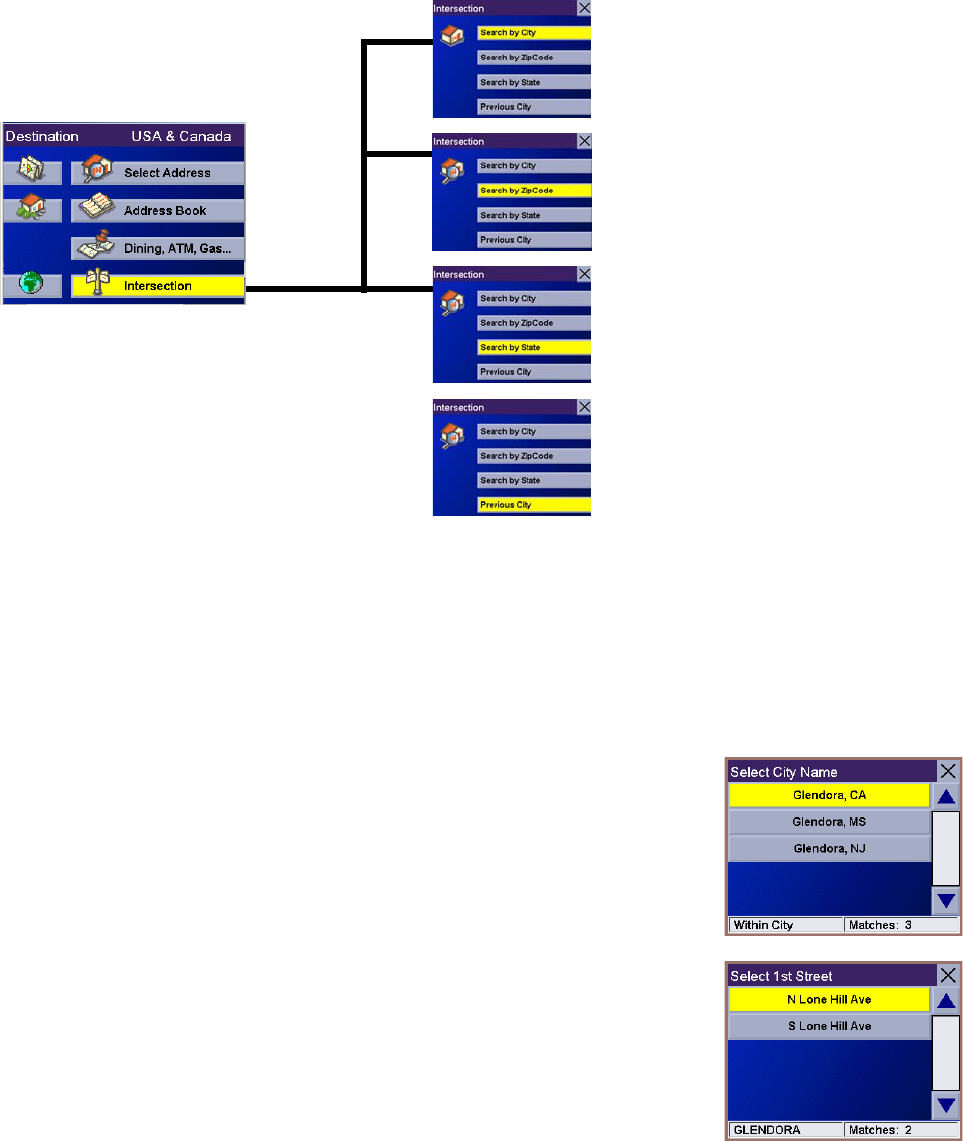
Chapter 7: Selecting Destinations
51
7.7 Selecting an Intersection as a Destination
An intersection of two streets can be used as a destination. The search for the intersection can be done whether or not you
know the city. If you know the city, you can start there; if you are unsure of the city, you can start with the state.
7.7.1 Search by City
From the Destination screen, select Intersection then, select Search by City.
Enter the first few characters of the city name (see “Inputting Text Characters” on
page 13). Select OK.
Use the Navigation key to scroll the list up or down (if necessary) and select the desired
city.
Enter the first street name (see “Help with Address Entry” on page 15). Select OK.
Use the Navigation key to scroll the list up or down and select the first street from the list.
Search by City – page 51
Search by Zip Code – page 52
Intersection Search by State – page 52
Previous City – page 53

Chapter 7: Selecting Destinations
52
Enter the second street name and select OK.
Use the Navigation key to scroll the list up or down (if necessary) and select the second
street from the list.
Select the desired Route Method.
The Magellan RoadMate 6000T will calculate the route. When the calculations are
complete, the Map screen will be displayed.
7.7.2 Search by Zip Code
From the Destination screen, select Intersection then, select Search by Zip Code.
Enter the zip code and select OK, then select the city.
Enter the first street name (see “Help with Address Entry” on page 15). Select OK.
Use the Navigation key to scroll the list up or down and select the first street from the list.
Enter the second street and select OK.
Use the Navigation key to scroll the list up or down (if necessary) and select the second
street from the list.
Select the desired Route Method.
The Magellan RoadMate 6000T will calculate the route. When the calculations are
complete, the Map screen will be displayed.
7.7.3 Search by State
From the Destination screen, select Intersection then, select Search by State.

Chapter 7: Selecting Destinations
53
Enter the first few characters for the state and select OK.
Use the Navigation key to scroll the list up or down (if necessary) and select the state from
the list.
Enter the first street name (see “Help with Address Entry” on page 15). Select OK.
Use the Navigation key to scroll the list up or down (if necessary) and select the first street
from the list.
Enter the second street and select OK.
Use the Navigation key to scroll the list up or down (if necessary) and select the second
street from the list.
Select the desired Route Method.
The Magellan RoadMate 6000T will calculate the route. When the calculations are
complete, the Map screen will be displayed.
7.7.4 Previous City
From the Destination screen, select Intersection then, select Previous City.
Use the Navigation key to scroll the list up or down (if necessary) and select the desired
city.
Enter the first street name (see “Help with Address Entry” on page 15). Select OK.
Use the Navigation key to scroll the list up or down (if necessary) and select the first street
from the list.
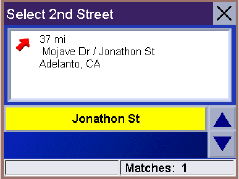
Chapter 7: Selecting Destinations
54
Enter the second street and select OK.
Use the Navigation key to scroll the list up or down (if necessary) and select the second
street from the list.
Select the desired Route Method.
The Magellan RoadMate 6000T will calculate the route. When the calculations are
complete, the Map screen will be displayed.

55
Chapter 8: Navigation Options
Navigation Options are only available when you are in Navigation Mode. When going to the Main
Menu from the Music Player or from the Photo Viewer, this option will be grayed out.
To access these features, press the MENU key on the Magellan RoadMate 6000T and select
Navigation Options.
8.1 Configuration
Configuration enables you to customize the advanced navigation features of the Magellan RoadMate 6000T.
Select Configuration.
8.1.1 POI Selection
From the POI Selection menu, you can choose which icons to display on the Map screen. We recommend being selective
about which icons you choose to display in order to prevent your map screen from being cluttered. For a list of POI
Categories, see “POI Categories” on page 117.
Select POI Selection.
Select Mark All to display all POI icons on the Map screen.
Select Clear All if you wish not to have any POI icons displayed on the Map screen.
You can also select individual icons to display or hide on the Map screen. When you have
finished, select Save to save your selection and return to the Configuration menu.
8.1.2 Custom POIs
The Custom POI menu enables you to select POIs previously loaded into your Magellan RoadMate 6000T using the Magellan
RoadMate POI Manager software (see page 112). The following instructions are assuming that you have loaded one or more
custom POIs into your Magellan RoadMate 6000T.
Select Custom POIs.

Chapter 8: Navigation Options
56
Select Select a POI File.
Use the Navigation key to scroll the list up or down (if necessary) and select a POI file. With the
file selected, you are returned to the Custom POIs menu.
Select Display Categories.
The categories you created are displayed in the same way as the built-in POIs.
Select Mark All to display all POI icons on the Map screen. Select Clear All if you wish not to
have any POI icons displayed on the Map screen. You can also select individual icons to display
or hide on the Map screen.
When you have finished, select Save to return to the Configuration menu
You can also be alerted when you approach a custom POI. The Set Alarm function works for
Custom POIs only and only if the POI has been selected to show on the Map screen. Select Set
Alarms.
Again, you can select all, none, or individual POIs to have an alert set. Select Mark All to set an
alert for all custom POI icons on the Map screen. Select Clear All if you wish not to have any
alerts set for custom POI icons displayed on the Map screen. You can also select individual
categories to have an alert set.
When you have finished, select Save to return to the Custom POIs menu.
With the POI alerts set, you can now choose at what point you will be alerted. Select Alert
Parameters.
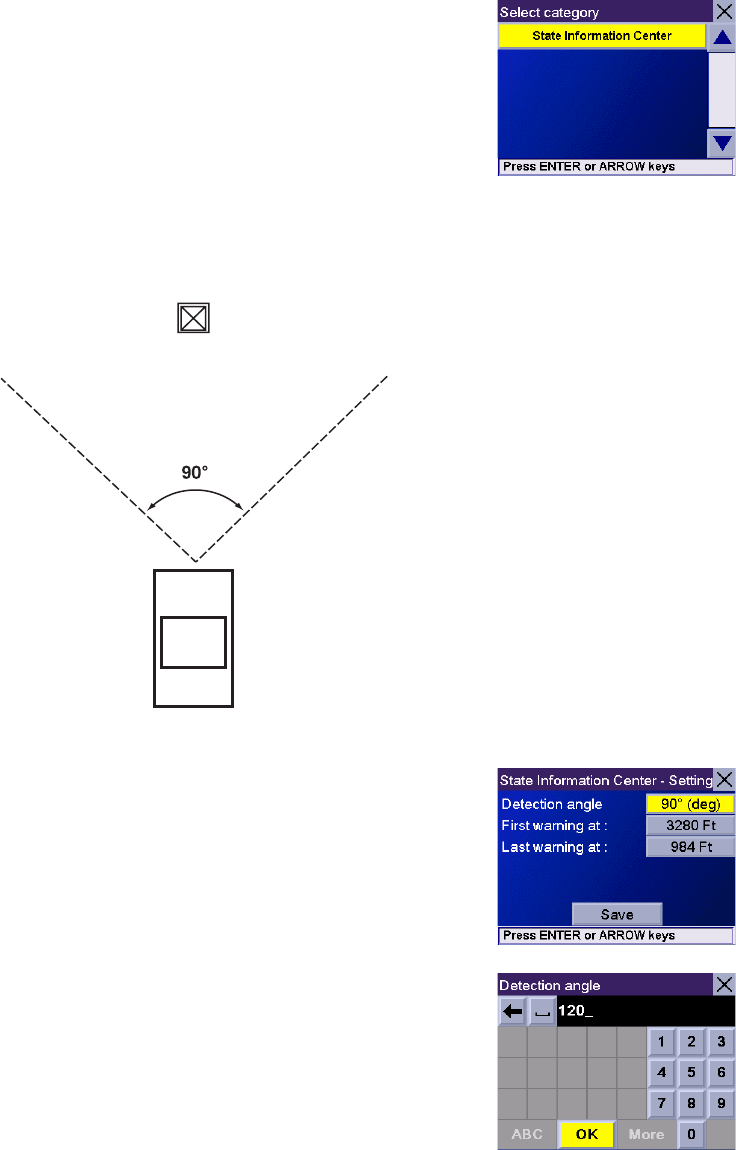
Chapter 8: Navigation Options
57
Select the POI category to customize.
The Detection Angle is set to alert you when you are within so many degrees of the POI.
Select Detection Angle.
Use the numeric keypad to enter the number of degrees in which to set the alert. When you
have finished, select OK.
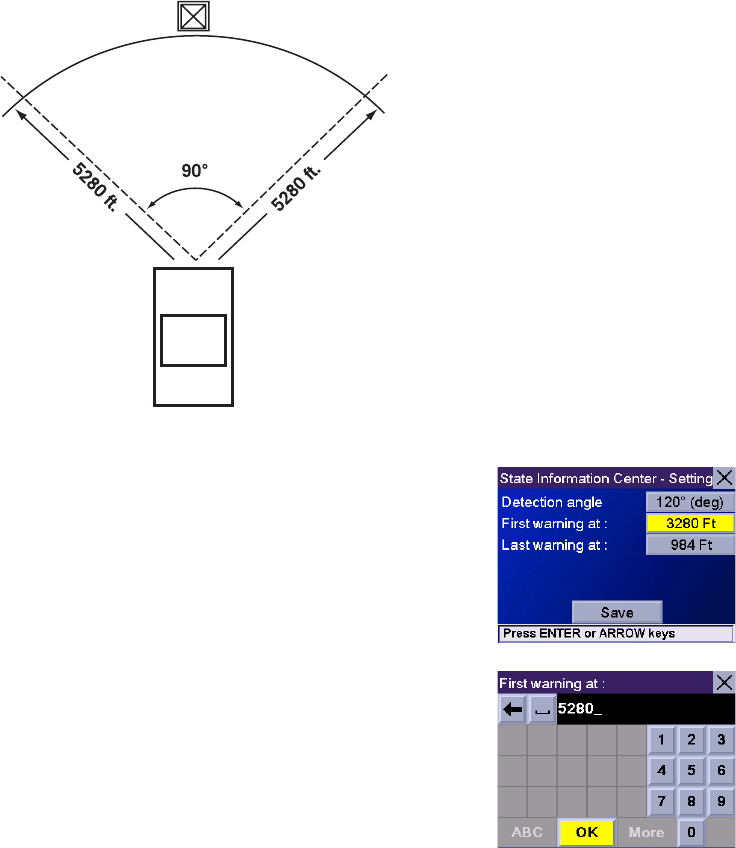
Chapter 8: Navigation Options
58
The First Warning is set to alert you when you are within a certain number of feet from the POI.
Select First Warning.
Use the numeric keypad to enter the number of feet in which to alert you. When you have
finished, select OK.
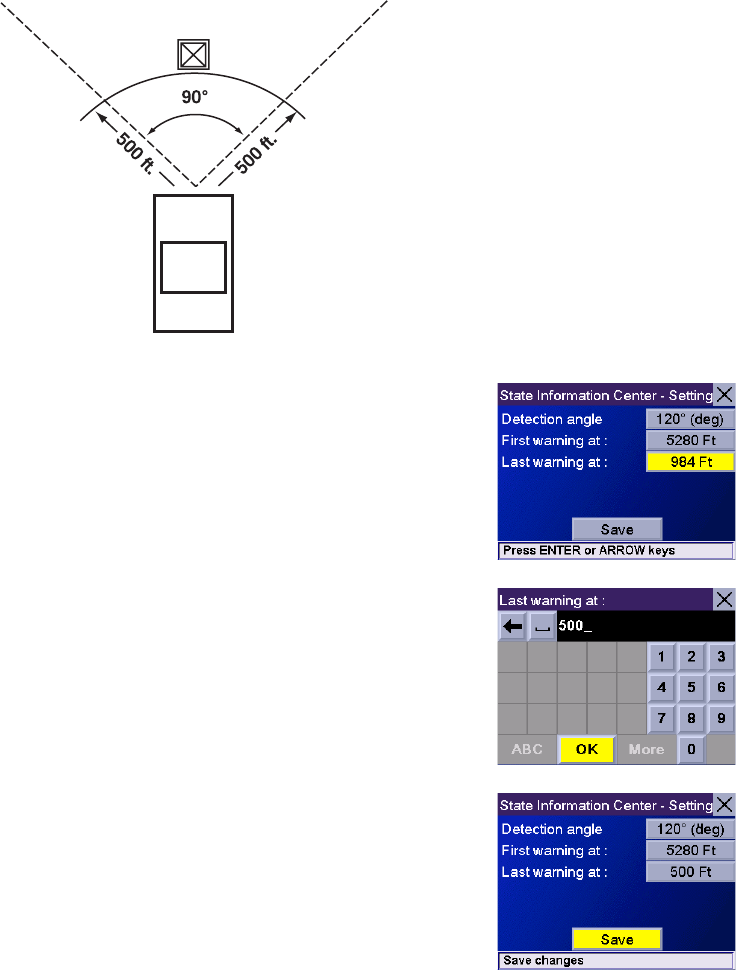
Chapter 8: Navigation Options
59
The Last Warning is set as a final alert when you are within a certain number of feet from the POI.
Select Last Warning.
Use the numeric keypad to enter the number of feet in which to alert you. When you have
finished, select OK.
When you have set the parameters as you like, select Save.

Chapter 8: Navigation Options
60
8.1.3 Map Options
Map Options enable you to determine the behavior of the Map while you are driving.
Select Map Options.
With Scrolling enabled, the vehicle position icon will always remain in the same position with
the map scrolling, or moving as while the vehicle is in motion. With Scrolling disabled, the
vehicle position icon will move forward slightly; then, the map will scroll down. Having Scrolling
disabled allows for a faster display.
Heading Up sets the map display so that the direction of travel is always at the top of the
screen. North Up sets the map display so that North is always at the top of the screen. North
Up is only available in 2D Map mode.
Select Miles or Kilometers as the unit of measure for distance.
When you have finished, select Save.
8.1.4 TrueView Options
TrueView options enable you to control how and when the TrueView screen is displayed. Select
TrueView Options.
Select Split TrueView to enable the TrueView/Map Screen mode. See “TrueView Screen” on
page 19.
Select Disable TrueView if you do not want the TrueView screen to appear during routing.
Select Manual TrueView to show the TrueView screen only by pressing the View key.
Select Auto TrueView to have the TrueView screen appear automatically when the next maneuver is approaching.
When you have finished, select Save.
8.1.5 Select Map Color
Select Select Map Color.
With Automatic Night Mode enabled, the Magellan RoadMate 6000T will switch between a Day screen and a Night screen
based on sunrise and sunset times for your current location.
Select Day Screen to choose a color scheme for the map while you are driving during the
day.
Select Night Screen to select a color scheme for driving at night.
When you have finished, select Save.
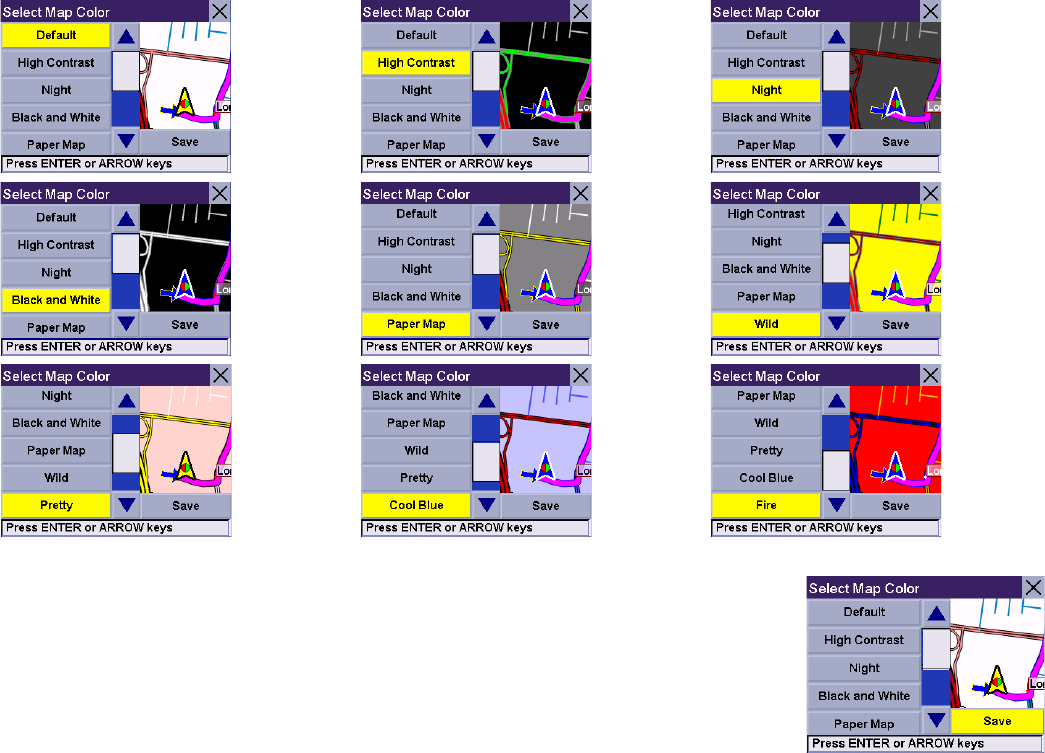
Chapter 8: Navigation Options
61
Select from nine available color schemes:
When you have finished, select Save and you will be returned to the Select Map Color menu.
8.1.6 Route Preferences
Route Preferences enable you to set parameters for the Magellan RoadMate 6000T to follow when calculating a route. Select
Route Preferences.
Automatic Re-Route will cause the Magellan RoadMate 6000T to try up to three times to automatically re-route to the
destination when it has detected that the vehicle has deterred from the calculated route.
When you have finished, select Save.

Chapter 8: Navigation Options
62
8.1.7 Detour Options
The Magellan RoadMate 6000T comes equipped with SmartDetour. If you are driving on the freeway with SmartDetour
enabled and your speed drops below 15 MPH, you may press the detour icon on the Map screen in order for the Magellan
RoadMate 6000T to calculate an alternate route around traffic.
Select Detour Options.
Select the distance of the detour. You can select from a preset distance of three miles, five
miles, or 10 miles.
You can also select a custom distance. Select Custom, and then select the button to the right
to enter a custom distance.
Enter the number of miles and select OK.
Next, select the amount of time the Magellan RoadMate 6000T will wait before alerting you.
Select the Time button.
Enter the number of minutes and select OK.
Enable Automatic Detour is selected by default as shown by the checkbox mark. To disable
automatic detour, deselect Enable Automatic Detour..
When you have finished, select Save.

Chapter 8: Navigation Options
63
When you encounter traffic, and the set time has elapsed, the Detour icon will flash on the Map
screen. Touch the icon on the screen to have the Magellan RoadMate 6000T calculate the
detour. You can choose to ignore the Detour alert; and after one minute it will stop flashing
until the set time has elapsed again when it will alert you once more.
8.1.8 Menu Colors
You can change the color of the menu screens by selecting one of four color schemes.
Select Menu Colors.
Select the desired color scheme.
When you have finished, select Save.
8.1.9 Tone Options
As you approach a maneuver, an audible alert sounds to let you know to make the maneuver.
Select Tone Options.
Select either Bell, Chime, or Beep.
When you have finished, select Save.
8.1.10 GPS Options
GPS Options provide you with information on the satellite signal as well as the ability to speed up signal acquisition time.
8.1.10.1 GPS Status
The GPS Status screen is available by pressing the GPS Signal icon on the Map screen (see
“Map Screen” on page 17) as well as through the GPS Options menu. GPS Status monitors the
satellite signal. For more information on the GPS Status screens refer to “GPS Status Screen”
on page 120.

Chapter 8: Navigation Options
64
8.1.10.2 Set GPS Position
Set GPS Position enables you to manually set the location of the Current Position icon. If you have travelled a long distance
with the Magellan RoadMate 6000T off, it may take some time for the Magellan RoadMate 6000T to reacquire a satellite
signal. By manually setting the position of the Magellan RoadMate 6000T, you are telling the Magellan RoadMate 6000T
where you are and will speed up the satellite signal acquisition. Make sure you first select the country you are in by pressing
the Globe button on the Destination screen (see “Country Selection (Globe Button)” on page 25). Select Set GPS Position.
Enter the first few characters of the city name (see “Inputting Text Characters” on page 13).
Select OK. Use the Navigation key to scroll the list up or down (if necessary) and select the
desired city.
Enter the street name (see “Help with Address Entry” on page 15). Select OK. Use the
Navigation key to scroll the list up or down (if necessary) and select the desired street.
Enter the street address. The acceptable range of numbers is displayed at the top of the screen.
If you do not know the exact address, just select Done and the Magellan RoadMate 6000T will
use the lowest number in the range. Select Done to continue. You will be returned to the
Configuration menu.
Go to the Map screen. Your current position is now set to the address you entered.
8.1.11 Simulator Mode
In Simulator Mode, you can demonstrate the capabilities of the Magellan RoadMate 6000T without actually driving. In order
for the simulation to work, you must set a route first. Select Simulator Mode.
Select Simulate to begin the simulation.
Set the speed variance of the simulation: x1 will “drive” at normal speed using known speed
limits; x1.5 will “drive” at one and a half times normal speed; x2 will “drive” at two times
normal speed.
Return to the Map screen to view the simulation.
To disable Simulator Mode, select Stop, or when the power is turned off the Simulator will stop.
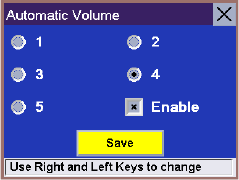
Chapter 8: Navigation Options
65
8.1.12 Automatic Volume
The Magellan RoadMate 6000T can be set to automatically increase the volume when the vehicle exceeds 45 MPH in order
to compensate for road noise.
Select Automatic Volume.
Select the number increment by which to increase the volume.
Select Enable.
When you have finished, select Save.
8.1.13 Backup and Restore
The Magellan RoadMate 6000T has the capability to back up your information (Address Book, Previous Destinations, etc.) to
an optional memory card.
8.1.13.1 Backup
Select Backup and Restore then, select Backup.
If you do not have a card inserted, you will be prompted to insert a card. Make sure the card is unlocked to allow data to be
copied to it. Insert a card and reselect Backup.
A dialog box will appear asking you to confirm your selection. Select Yes.
The files are copied to the memory card.
8.1.13.2 Restore
To restore the files to the hard disk, select Backup and Restore then, select Restore.
If you do not have a card inserted, you will be prompted to insert a card. Insert a card and reselect Restore.
A dialog box will appear asking you to confirm your selection. Select Yes.
The files are copied to the hard disk.

Chapter 8: Navigation Options
66
8.1.14 Map Information
Product Information displays information about the map and database installed in your
Magellan RoadMate 6000T. This information aids our Technical Support Representative in
finding a solution to whatever problem you may have.
8.2 Trip Computer
The Trip Computer is a valuable tool for recording the mileage and time spent driving while on business or vacation. The
information for the trip can be saved and viewed at any time, providing you easy access to information on your current trip,
as well as previous trips.
To access these features, press the MENU key on the Magellan RoadMate 6000T and select
Navigation Options.
Select Trip Computer.
8.2.1 Current Trip
When you begin a new trip and you need to record the information, access the Trip Computer. There you can save the
information displayed for the current trip (if needed) and reset the Trip Computer to zero in preparation for your new trip.
Select Trip Computer
Select Current from the list of saved Trip Reports.

Chapter 8: Navigation Options
67
The Trip Computer is always in a “Running” state. The information for the current trip is
displayed.
8.2.1.1 Stopping or Starting the Trip Computer
At any time the Trip Computer can be stopped and started. If the Trip Computer is currently
running, select Stop. The Trip Computer will stop recording until restarted or reset.
While the Trip Computer is in a “Stopped” state, select Start to continue recording the current
trip or select reset to begin a new trip.
8.2.1.2 Saving the Current Trip Report
When you have finished with your trip, you can save the information for later viewing. Select
Save at any time.
Use the keypad to enter a name for the Trip Report and select OK when you are finished.

Chapter 8: Navigation Options
68
8.2.1.3 Resetting the Trip Computer
Before starting a new trip that you want to record, you need to reset the Trip Computer first.
Select Reset and the information will be set to zero. The Trip Computer will remain in a
“Running” state.
8.2.1.4 Viewing a Saved Trip Report
From the Trip Computer screen, select the Trip Report you wish to view.
The saved Trip Report is displayed. Press the ESCAPE key when you are finished to view the
trip and return to the Trip Computer screen.
8.2.1.5 Deleting a Trip Report
Select the Trip Report to be deleted.
Select Delete.
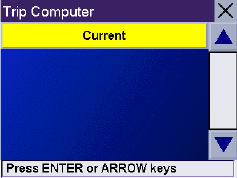
Chapter 8: Navigation Options
69
The trip is deleted and you are returned to the Trip Computer screen.
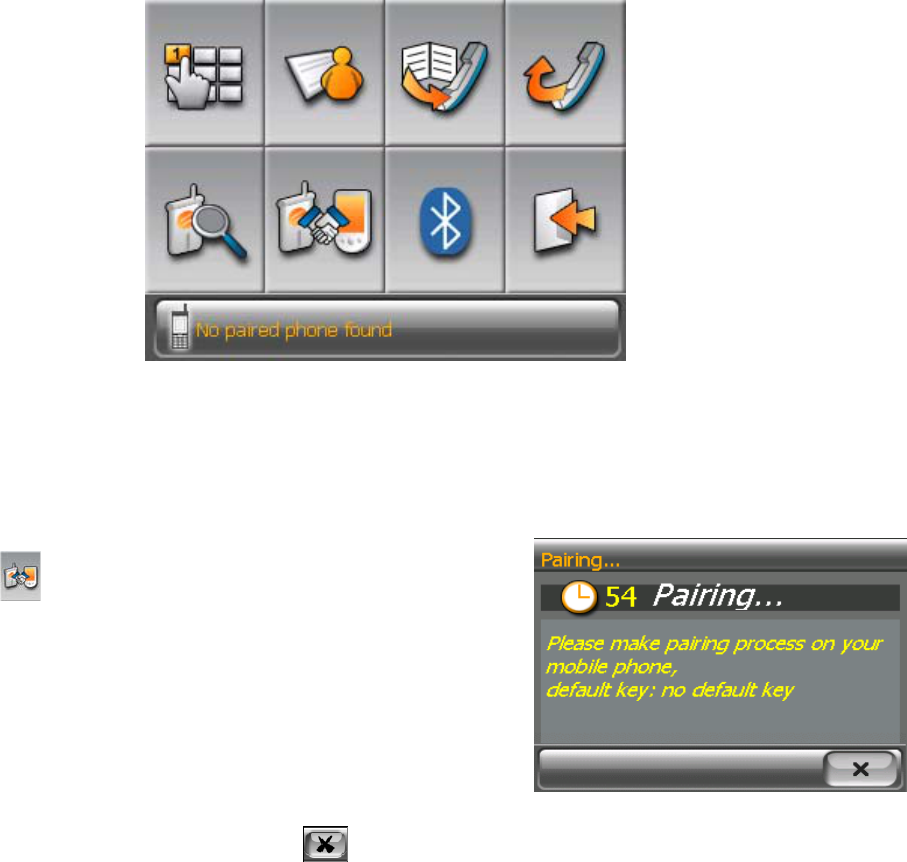
70
Chapter 9: Bluetooth
9.1 How to use the Dialer
9.1.1 Introduction
The Dialer program is a main part of Magellan RoadMate 6000T that allows you to use it as a Hands-free device for a
Bluetooth wireless-technology enabled mobile phone. You can tap your Magellan RoadMate 6000T to place and receive calls
instead of pressing the phone’s keypads. It’s a solution of wireless connection between the Magellan RoadMate 6000T and
the Bluetooth wireless-technology enabled mobile phone.
9.1.2 Main Interface
The main interface of BlueSoleil™ is as below:
9.1.3 Pair Mode
For the first time of use, no mobile phone paired or connected. The system will automatically switch “Pair Mode” to waiting
for pairing action from your mobile phone.
9.1.3.1 The pairing window shall pop up, if it is not the first time of use,
you need to click in the main interface.
Notes: The paring mode can be canceled by clicking in the paring window. Pairing will be failed if the process cannot
be finished within 1 minute.
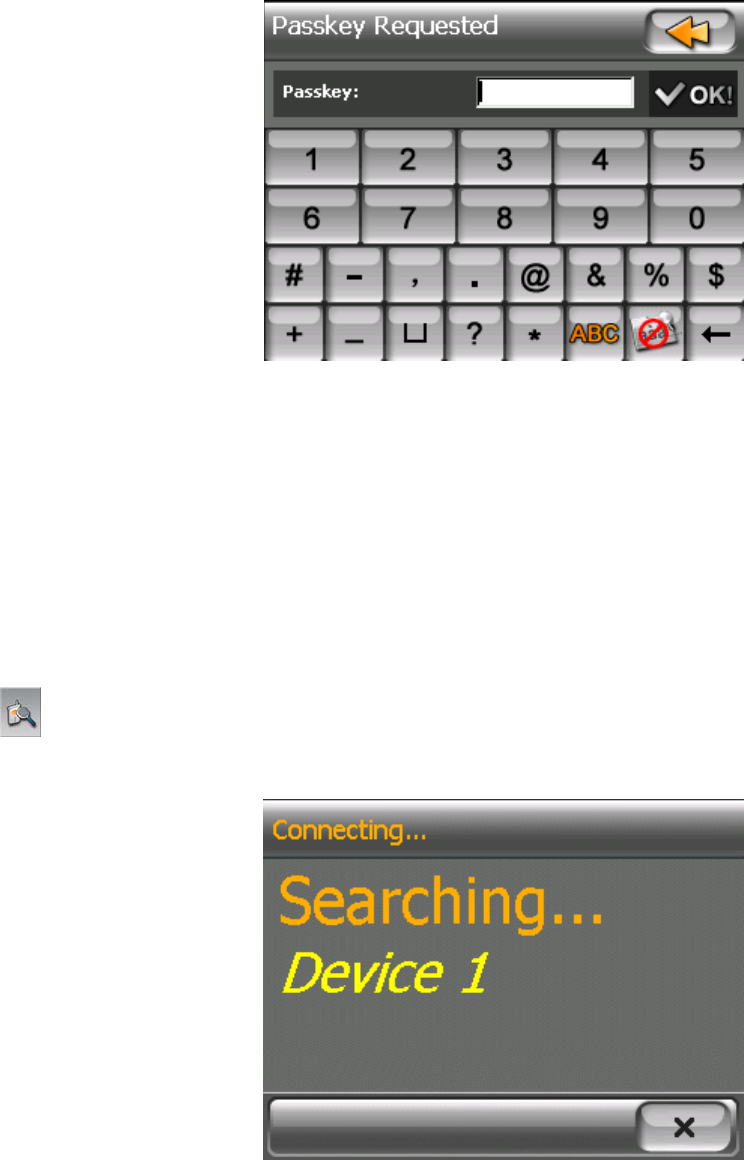
Chapter 9: Bluetooth
71
9.1.3.2 Make paring process on your mobile phone. (See the user guide of your mobile phone.)
Figure 3~3
9.1.3.3 After you input the passkey in your mobile phone, there shall be a passkey input window pop up in your Magellan
RoadMate. Then you need to input the same numbers as you input to your mobile phone to this pop up window.
9.1.4 Establish Connection
There are two ways to establish connection with the Bluetooth wireless technology enabled mobile phone.
9.1.4.1 Connect
Tap in the main interface to search and connect your paired mobile phone.
Figure 3~4
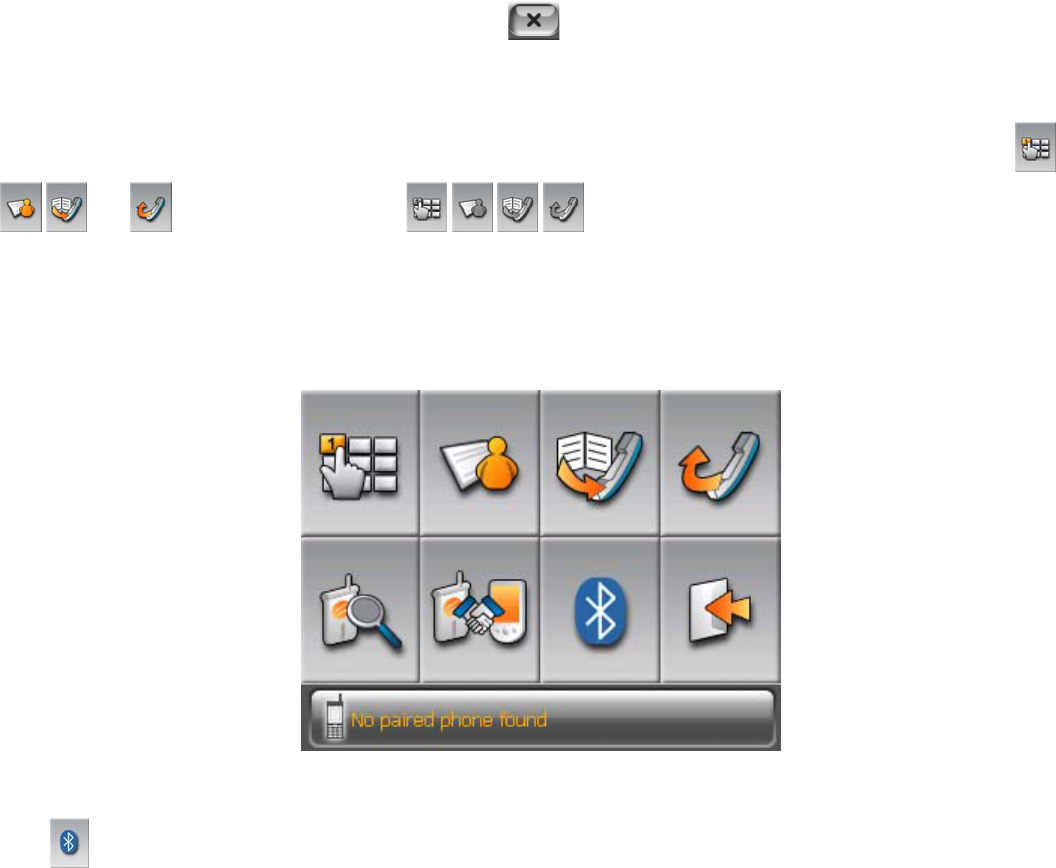
Chapter 9: Bluetooth
72
Note:
• The device searching mode can be canceled by clicking in the connecting window.
• If your mobile phone doesn’t support “Hands-free” service and just support the “Headset” service, you needn’t connect. If
you dial a number out from your mobile phone or incoming call the “Headset” service shall be connected automatically. The
main interface shall show up with a status message "xx connected, partial function supported only", and the button
and shall be turned to grey as .
9.1.4.2 The other way to connect
You can run the BlueSoleil™ program by tapping “Bluetooth” icon in the main interface.
Figure 3~5
Click button to enter the “Bluetooth Manager” Window.
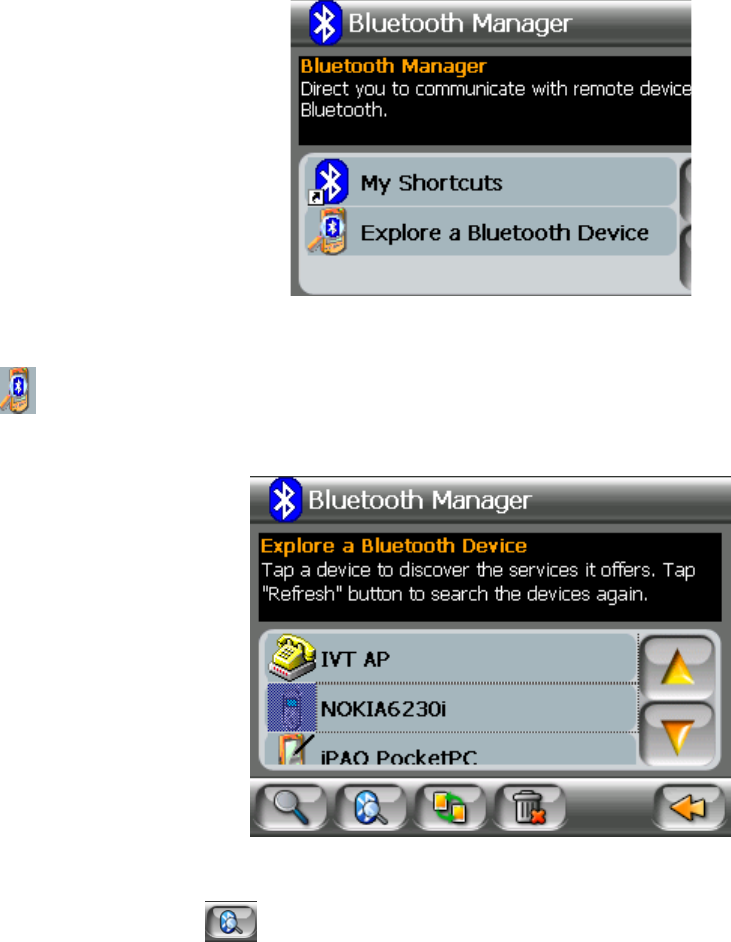
Chapter 9: Bluetooth
73
Click to explore the Bluetooth wireless technology enabled mobile phone.
Figure 3~7
Select a mobile phone, click to see the services that the mobile phone provided.
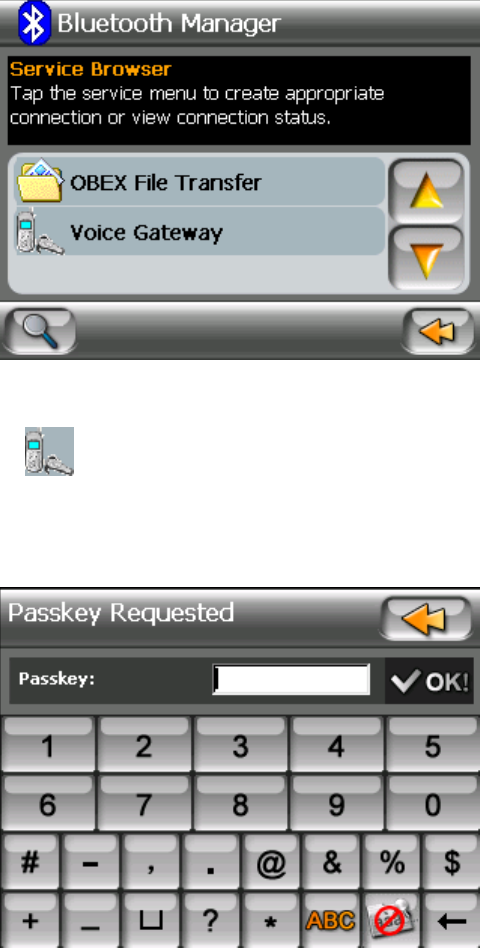
Chapter 9: Bluetooth
74
Figure 3~8
Select Hands-free Service, and Click to make connection with the hands-free mobile phone. Then there shall be a
passkey input window pop up in your mobile phone if you haven’t paired your mobile phone with the Magellan RoadMate
before. You need input not more than 16 digital numbers you want to use as passkey to pair with the Magellan RoadMate.
Figure 3~9
After you input the passkey in your mobile phone, there shall be a passkey input window pop up in your Magellan RoadMate.
You need to input the same numbers you have inputted in your mobile phone.
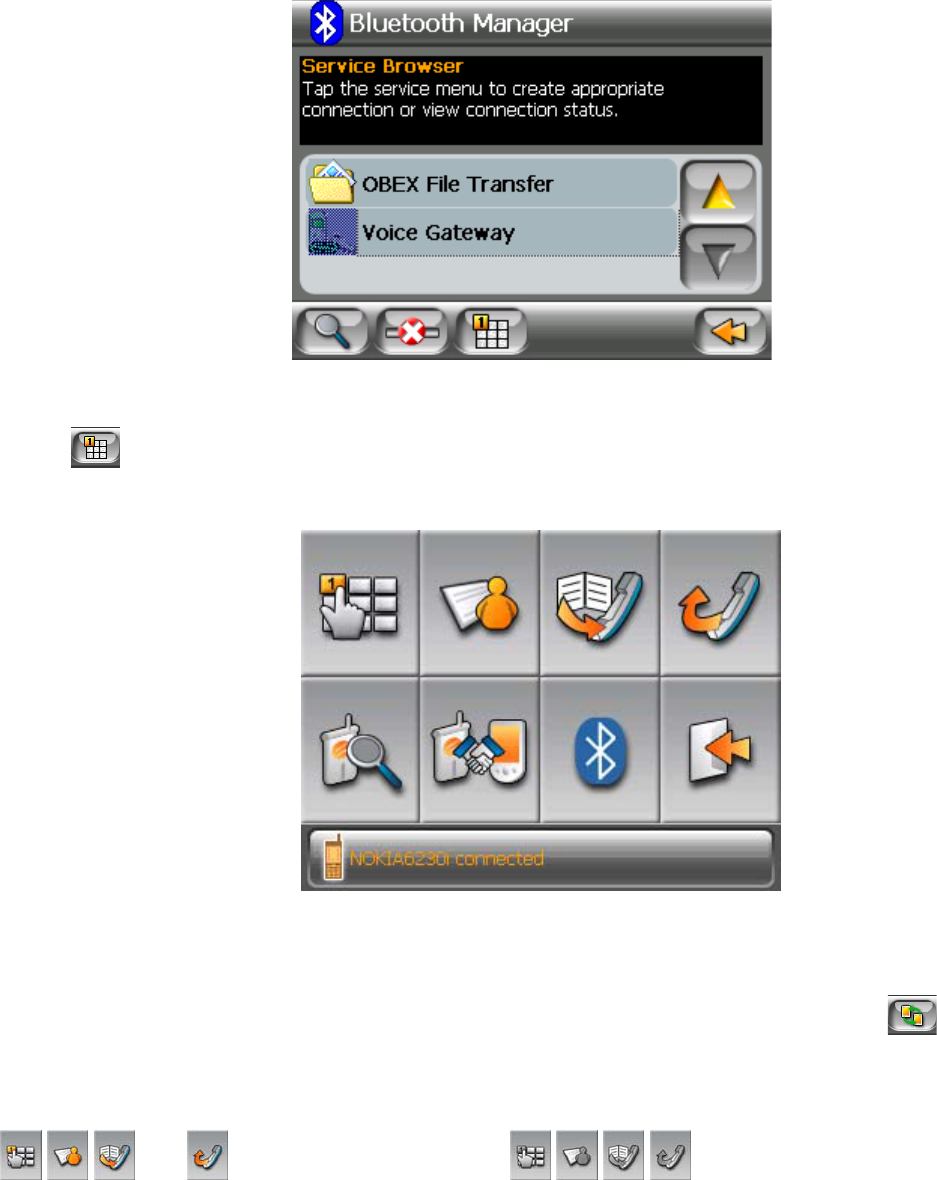
Chapter 9: Bluetooth
75
Figure 3~10
Tap the icon to back to the main interface once the connection has been established.
Figure 3~11
Note: If your mobile phone doesn’t support “Hands-free” service and just support the “Headset”
service, you just need choose your mobile phone in the device list (Figure 3~7), tap (Figure 3~7)
to pair with your mobile phone, and no need to connect. If you dial a number out from your mobile
phone or an incoming call the “Headset” service shall be connected automatically. The main interface
shall show up with a status message "xx connected, partial function supported only", and the button
and shall be turned to grey as .
9.1.5 Place a call
You can make calls out after “Hands-free” connected successfully.
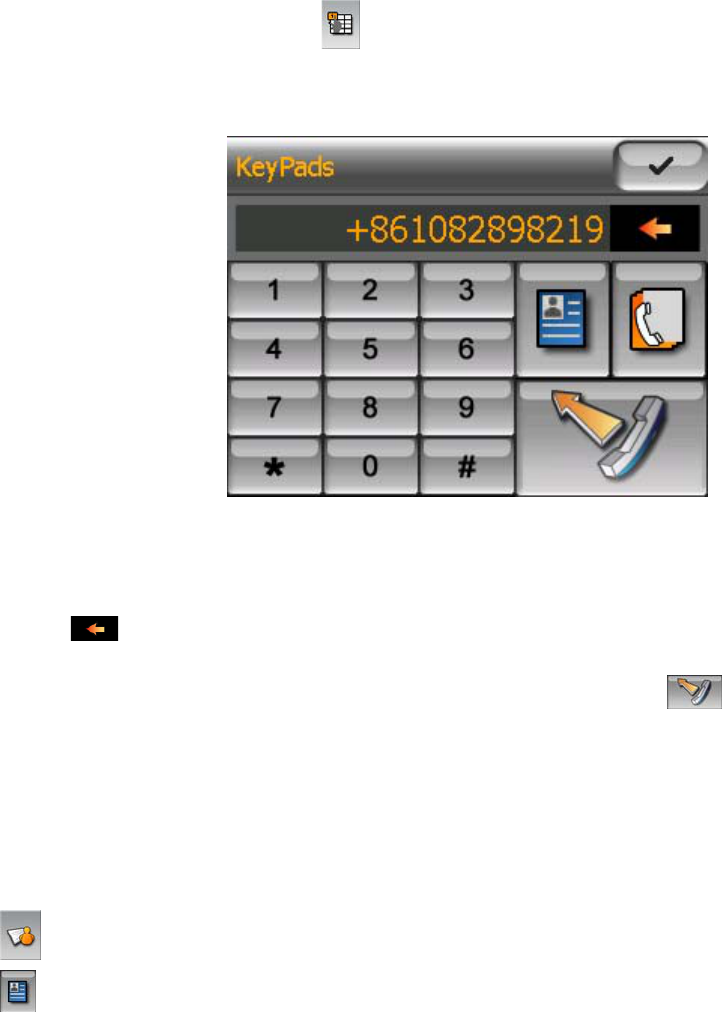
Chapter 9: Bluetooth
76
Four ways are available:
• Place a call via Keypads
• Place a call via Contacts
• Place a call via Call History
• Place a call via Redial.
9.1.5.1 Place a call via Keypads
For place a call via keypads, you need to tap in the main interface (Figure 3~11). Then the keypads window shall pop
up as below.
Figure 3~12
•You can input 13 characters: “0~9”, “﹡” and “#” with the buttons in the keypads. Input “+” by tapping the “ ﹡” for about
1 second.
• You can tap to delete the phone number you have inputted. Tap the button for about 1 half seconds the entire row
shall be deleted.
• Once you have inputted the phone number you want to dial out, you need to tap to dial out the call.
9.1.5.2 Place a call via Contacts
If you have stored your contacts’ information in the “Contacts” (Figure 2~1), you can place the call via “Contacts”.
There are two ways to use the “Contacts” to place a call:
• Tap in the main interface (Figure 3~11).
• Tap in the “Keypads” window (Figure 3~12).
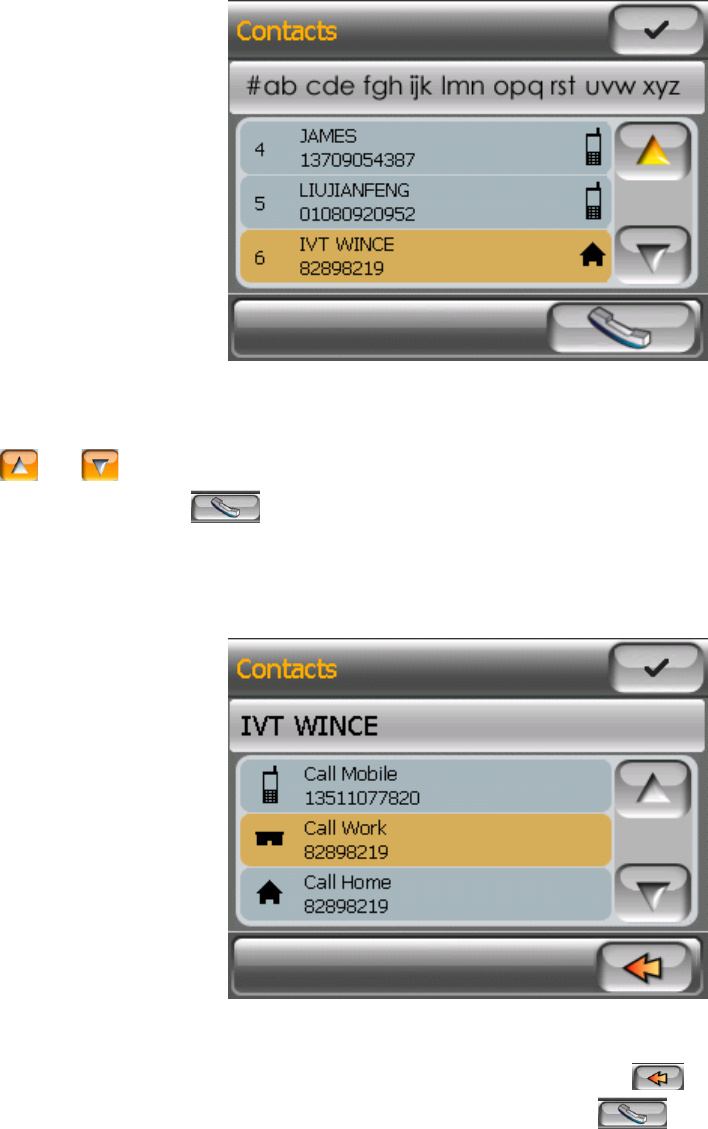
Chapter 9: Bluetooth
77
Figure 3~13
• Use the “Alphabetical index” to find a contact.
• Tap and to move up and down to find a contact.
• Choose a contact and tap to call the contact.
Tap a contact, the detail phone information shall pop up as below:
Figure 3~14
• Choose the “Call Mobile”, “Call Work” or the “Call Home”, tap to back to the forward window
(Figure 3~13), and then you can choose a contact and tap to call the contact.
9.1.5.3 Place a call via Call History
The “Call History” window displays the list of calls you have dialed out before, and is divided into 3 pages: Incoming /
Outgoing / Missed. It will store the latest 20 calls of incoming call/Outgoing call/Missed call numbers. (Total: 60)
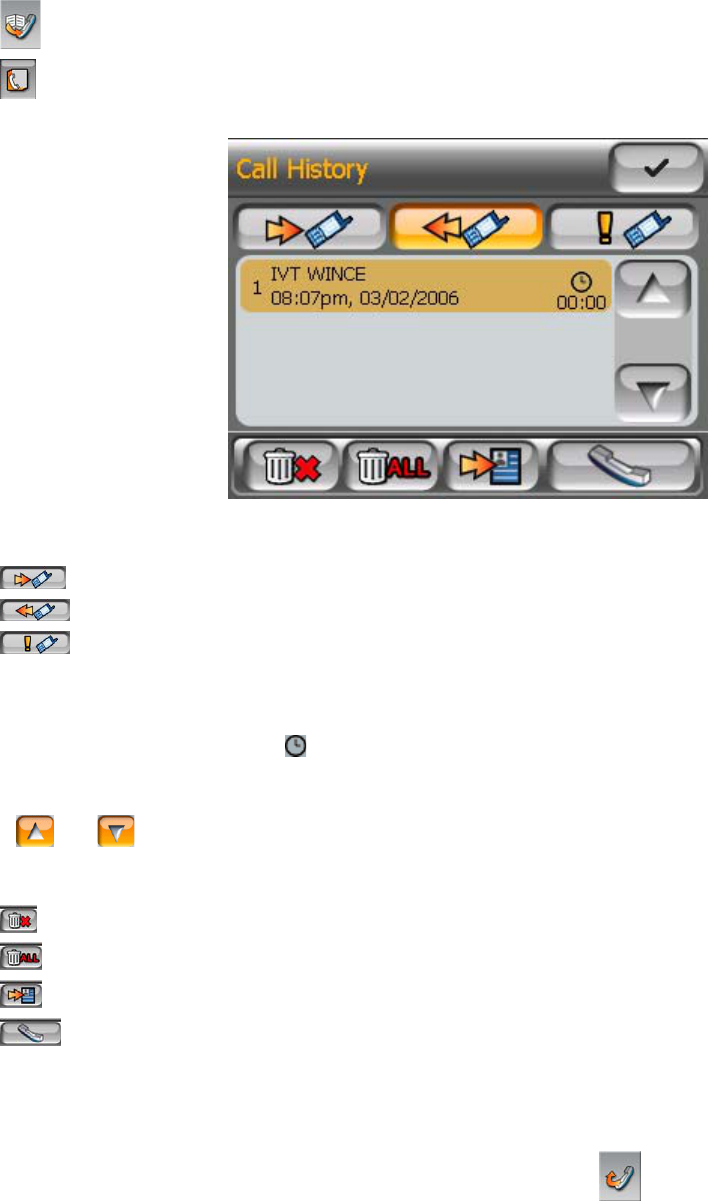
Chapter 9: Bluetooth
78
There are two ways to use the “Call History” to place a call:
• Tap in the main interface (Figure 3~11).
• Tap in the “Keypads” window (Figure 3~12).
Figure 3~15
• Tap to check the history of incoming calls.
• Tap to check the history of outgoing calls.
• Tap to check the history of missed calls.
• The records are stored as this format: <Phone Number> or <Caller Name>
• <HH:MM> <AM/PM>, <MM/DD/YY> <HH:MM:SS>
• • Tap and to move up and move down to find a record.
• Tap to delete a record selected.
• Tap to delete all records in the page.
• Tap to save a caller’s information to “Contacts”.
• Tap to call back.
9.1.5.4 Place a call via Redial
You can redial the last phone number you have called or received by tapping in the main interface (Figure 3~11).
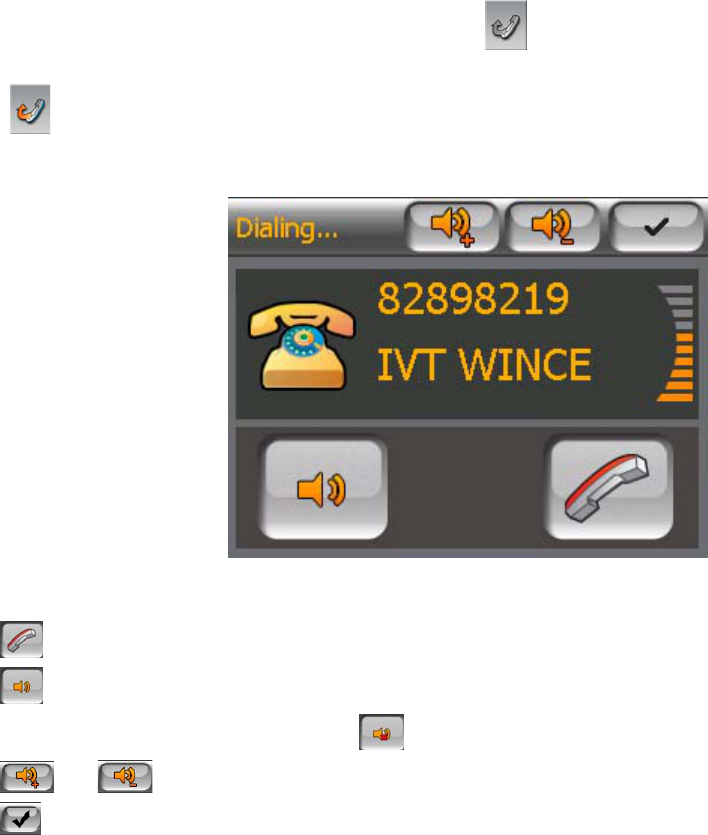
Chapter 9: Bluetooth
79
Note: If there is no any call history, the button will be shown as in the main interface (Figure 3~11).
After tap the dialing window shall pop up as below:
Figure 3~16
• Tap to cancel the dialing.
• Tap to mute the waiting ring before the call was received.
• After tapping the mute button, it will show as , tap it to cancel mute.
• Tap and to turn up and down the volume of waiting ring before the call was received.
• Tap to set the window as minimum as an icon before other windows.
9.1.5.5 Dial Fail
If dial failed due to network trouble or other unknown reasons, the “Dialing Failed” window shall pop up as below:
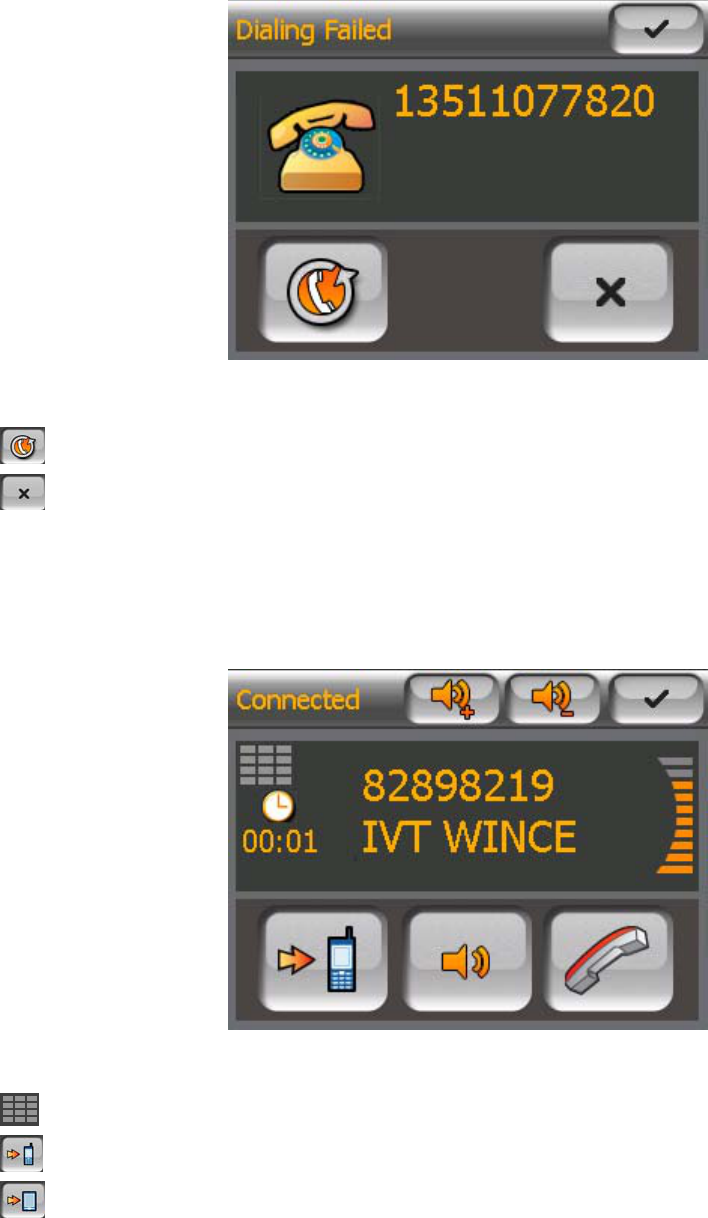
Chapter 9: Bluetooth
80
Figure 3~17
• Tap to redial.
• Tap to cancel dial.
9.1.5.6 Dial Success
If dial success, the “Connected” window shall pop up as below:
Figure 3~18
• Tap to pop up keypads to input the extension after connected.
• Tap to transfer the call to your mobile phone.
• Tap to transfer the call back to your Magellan RoadMate after you have transferred the call to your mobile phone.
Note: Some mobile phones don’t support cycled transfer, so in this condition, you need to transfer the call back to your
Magellan RoadMate from your mobile phone if you have transferred the call to your mobile phone before.
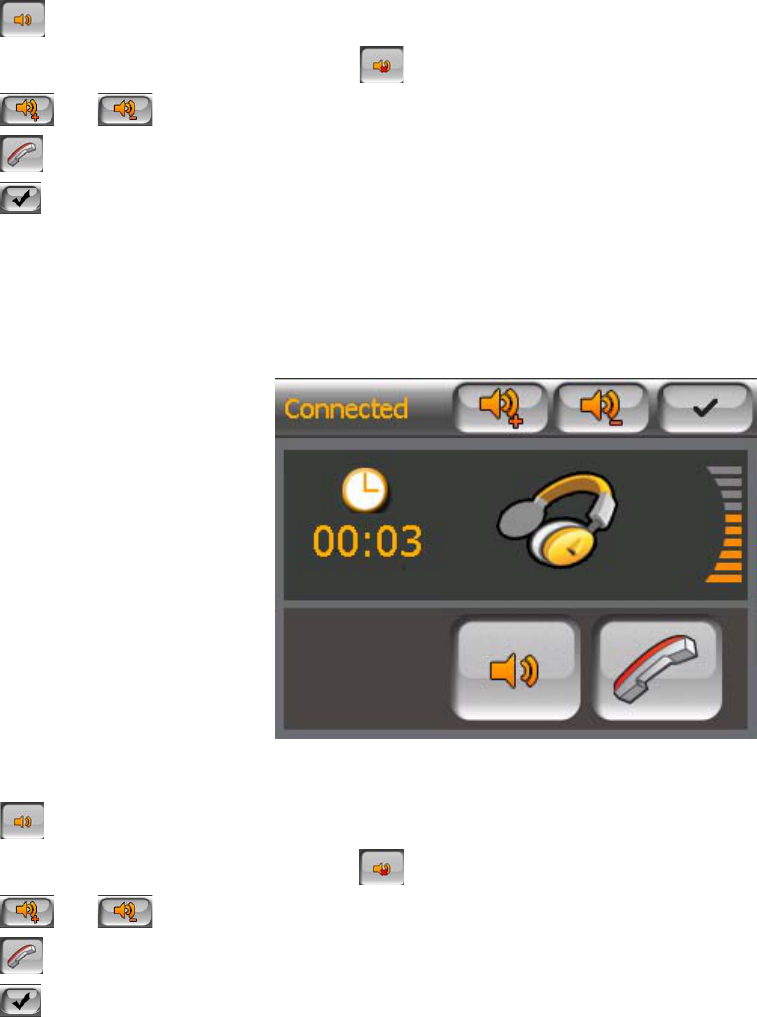
Chapter 9: Bluetooth
81
• Tap to mute the microphone in your Magellan RoadMate.
• After tapping the mute button, it will show as , tap it to cancel mute.
• Tap and to turn up and turn down the volume of the call.
• Tap to hang up the call.
• Tap to set the window as minimum as an icon before other windows.
Note: If the mobile phone that has paired with the Magellan RoadMate does not support the Hands-free service and only
support the Headset service, when you make a call out from that mobile phone the connected window shall be displayed as
below:
Figure 3~18(2)
• Tap to mute the microphone in your Magellan RoadMate.
• After tapping the mute button, it will show as , tap it to cancel mute.
• Tap and to turn up and turn down the volume of the call.
• Tap to hang up the call.
• Tap to set the window as minimum as an icon before other windows.
9.1.6 Incoming call
When there is an incoming call, the “Incoming Call” window shall pop up as below:
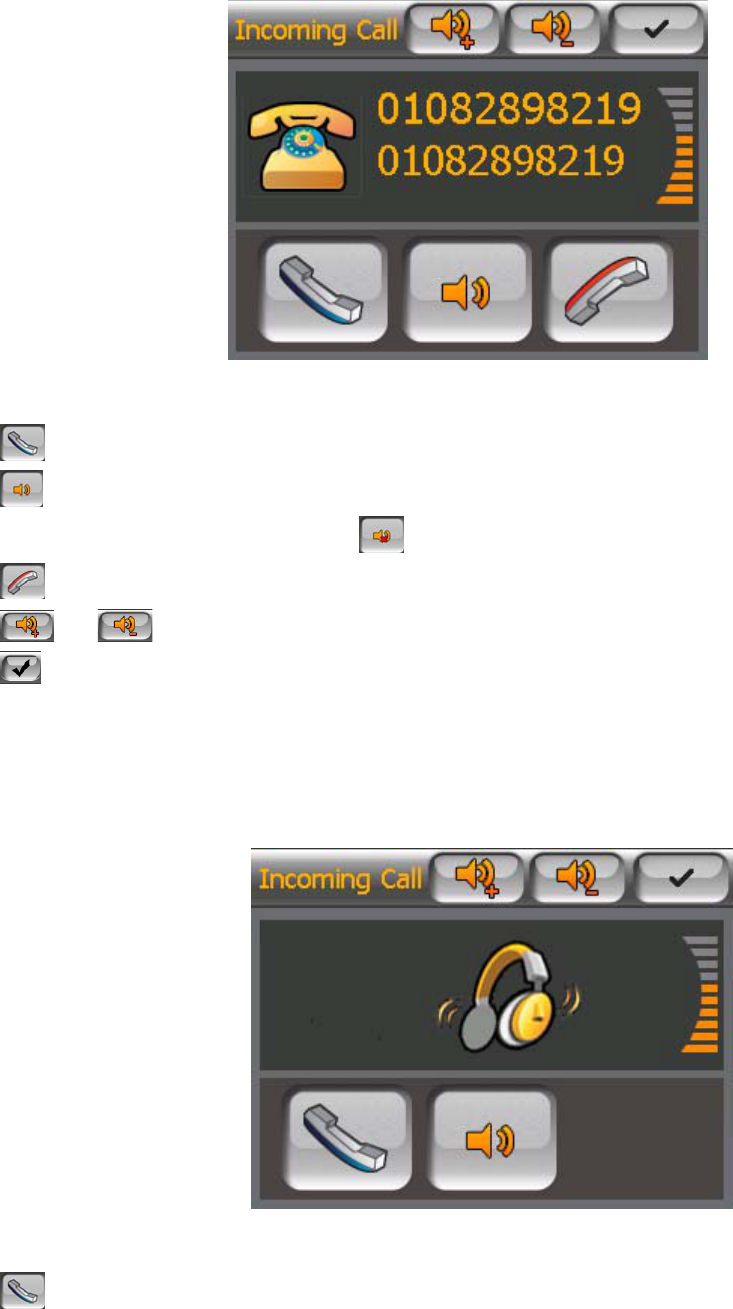
Chapter 9: Bluetooth
82
Figure 3~19
• Tap to pick up the incoming call.
• Tap to mute the incoming call ring.
• After tapping the mute button, it will show as , tap it to cancel mute.
• Tap to reject the incoming call.
• Tap and to turn up and turn down the volume of incoming call ring.
• Tap to set the window as minimum as an icon before other windows.
Note: If the mobile phone that has paired with the Magellan RoadMate does not support the Hands-free service and only
support the Headset service, the “Incoming Call” window shall be displayed different from the figure 3~19. It shall be
displayed as below:
Figure 3~19(2)
• Tap to pick up the incoming call.
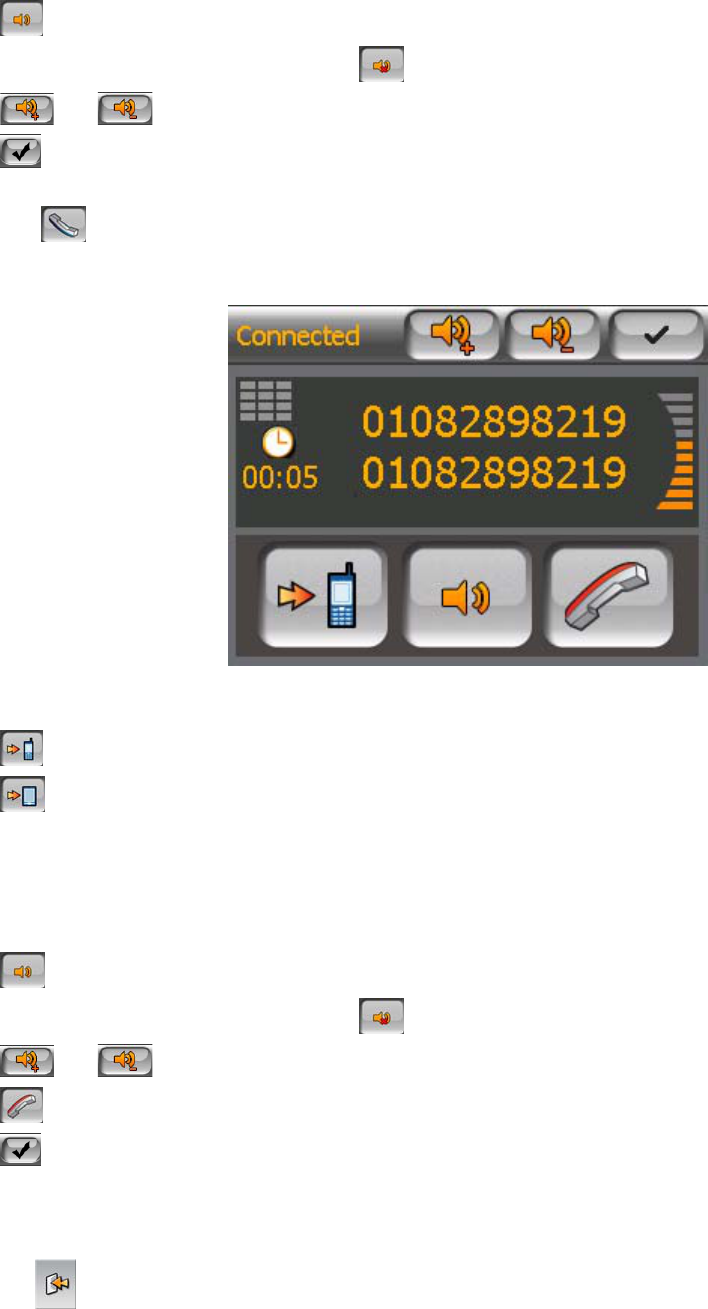
Chapter 9: Bluetooth
83
• Tap to mute the incoming call ring.
• After tapping the mute button, it will show as , tap it to cancel mute.
• Tap and to turn up and turn down the volume of incoming call ring.
• Tap to set the window as minimum as an icon before other windows.
After tapping , the “Connected” window shall pop up as below:
Figure 3~20
• Tap to transfer the call to your mobile phone.
• Tap to transfer the call back to your Magellan RoadMate after you have transferred the call to your mobile phone.
Note: Some mobile phones don’t support to cycled transfer, in this condition, you need to transfer the call back to your
Magellan RoadMate from your mobile phone if you have transferred the call to your mobile phone before.
• Tap to mute the microphone in your Magellan RoadMate.
• After tapping the mute button, it will show as , tap it to cancel mute.
• Tap and to turn up and turn down the volume of the call.
• Tap to hang up the call.
• Tap to set the window as minimum as an icon before other windows.
9.1.7 Exit
You can tap in the main interface (Figure 3~11) to exit Dialer of BlueSoleil™. Actually it is still running in background.
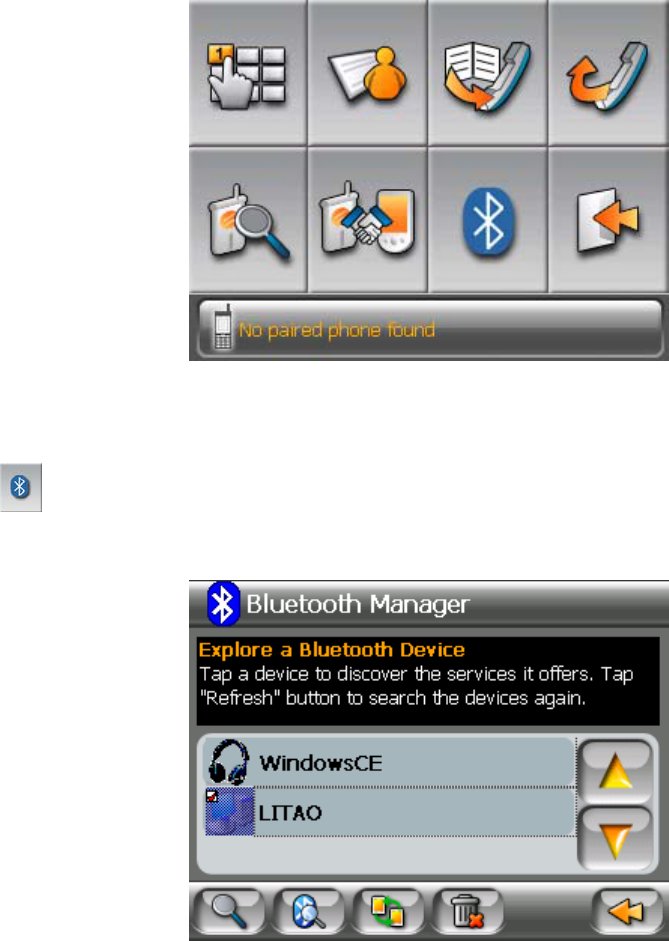
Chapter 9: Bluetooth
84
9.2 How to Transfer files via Bluetooth wireless technology
You can transfer files between your Magellan RoadMate and the remote device via Bluetooth wireless technology. Such as
downloading files from the remote device with Bluetooth wireless technology and uploading files to that device.
Figure 4~1
9.2.1 Tap to enter “Bluetooth Manager” window.
Figure 4~2
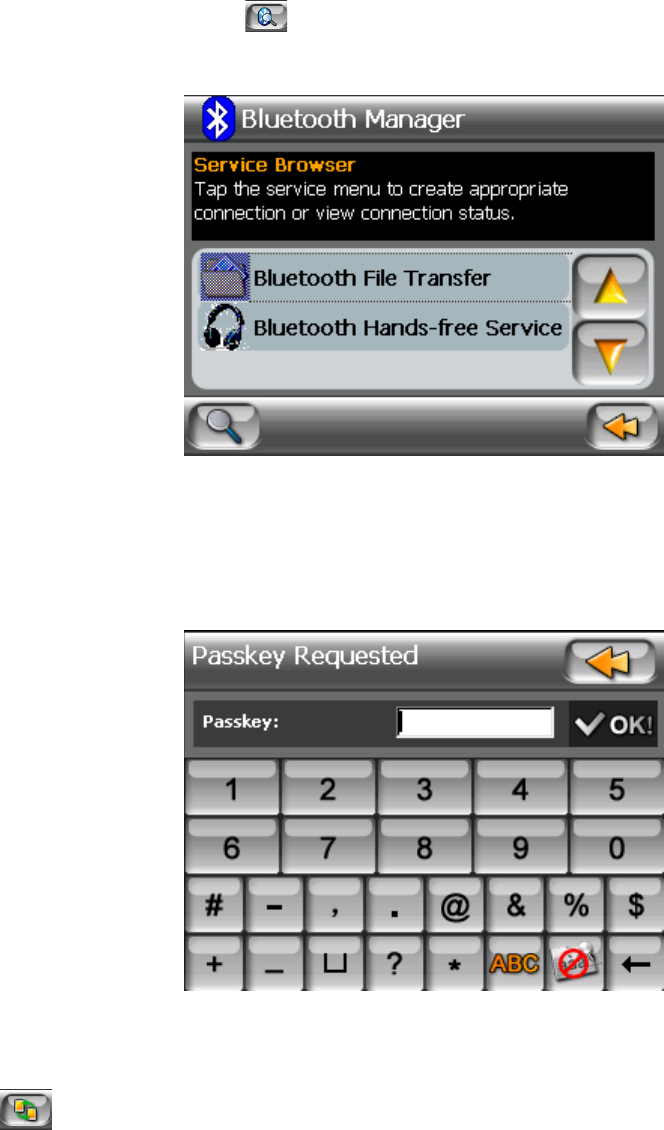
Chapter 9: Bluetooth
85
9.2.2 There are two ways (4.2.1 and 4.2.2) to connect to the “Bluetooth File Transfer” service of a
remote device:
Select a device in the device list and tap to browse the service that the device provides (Figure 4~2).
Figure 4~3
Tap t he “Bluetooth File Transfer” to connect to the remote device, and then the “Passkey Request” window shall pop up as
below:
Figure 4~4
9.2.2.1 Tap in the “Bluetooth Manager” window (Figure 4~2), the “Passkey Request” window shall
pop up as Figure 4~4.
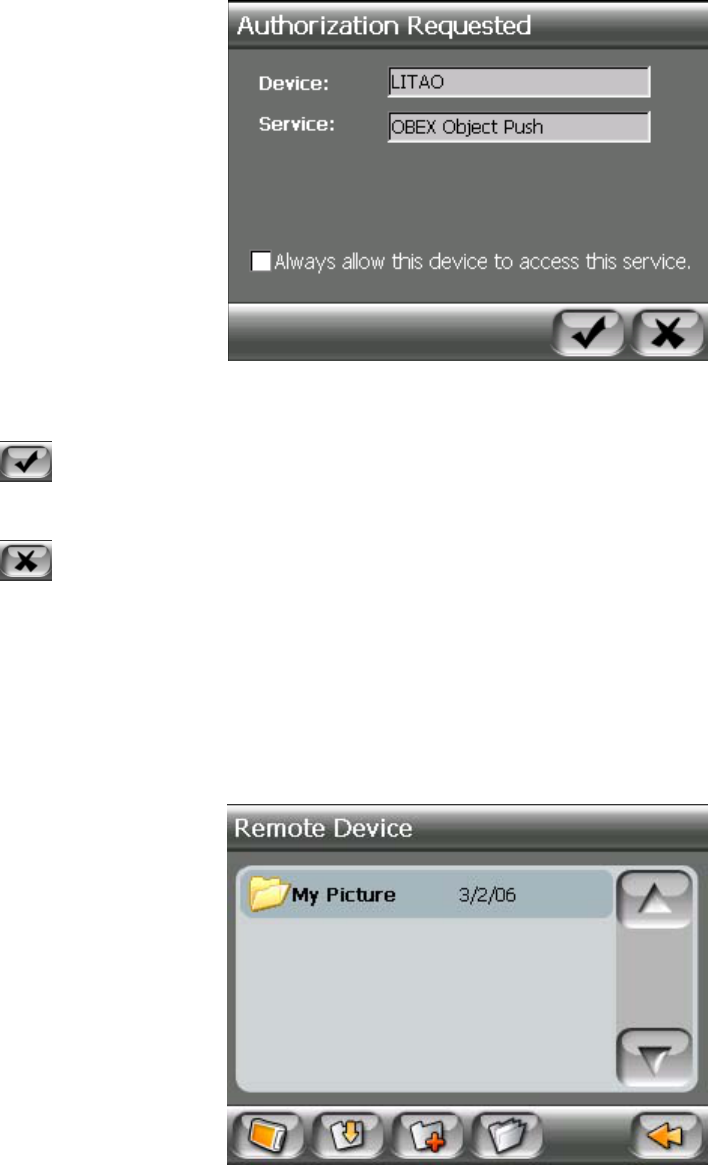
Chapter 9: Bluetooth
86
Note: If other device with Bluetooth wireless technology connects to the FTP service of your Magellan RoadMate, an
Authorization Requested window shall pop up as below:
Figure 4~5
• Tap to accept the connecting request.
• Once you have checked the checkbox before “Always allow this device to access this service”, this device should be able
to connect to your Magellan RoadMate without authorization in the next time.
• Tap to reject the connecting request.
9.2.3 Input the passkey you set that is not more than 16 digital numbers, and then the “Remote
Device” window shall pop up as below:
Figure 4~6
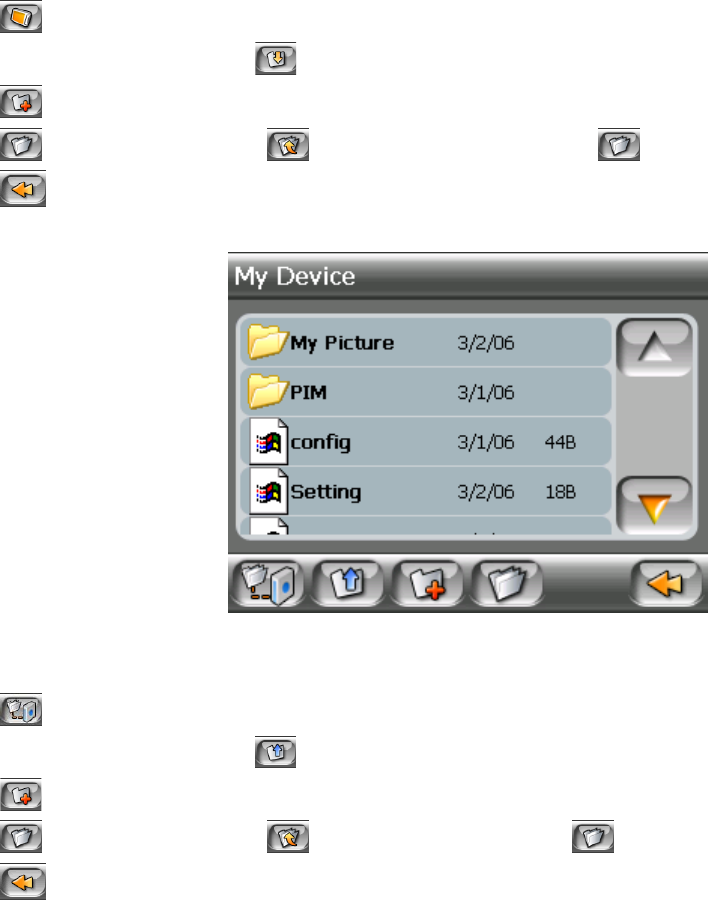
Chapter 9: Bluetooth
87
• Tap to view the share folders and share files in your Magellan RoadMate. (Figure 4~7)
• Choose a folder or a file, and tap to download it to your Magellan RoadMate. (Figure 4~8)
• Tap to add a new folder to the remote device.
• Tap to open a folder, and tap to go back after you have tapped
• Tap to exit the file transfer.
Figure 4~7
• Tap to view the share folders and share files in the remote device. (Figure 4~5)
• Choose a folder or a file, and tap to upload it to the remote device. (Figure 4~9)
• Tap to add a new folder to your Magellan RoadMate.
• Tap to open a folder, and tap to back after you have tapped
• Tap to exit the file transfer.
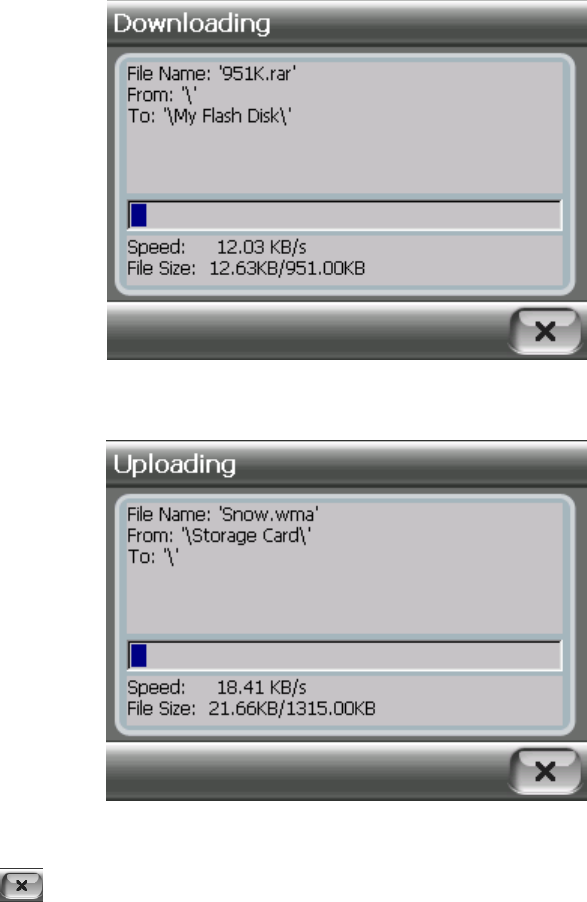
Chapter 9: Bluetooth
88
Figure 4~8
Figure 4~9
Note: You can tap to cancel the file transferring.
9.3 How to use My Shortcuts
The connection you have connected to shall be stored in “My Shortcuts”, you can delete the shortcut and can reconnect the
device you have connected to by tapping the shortcut.
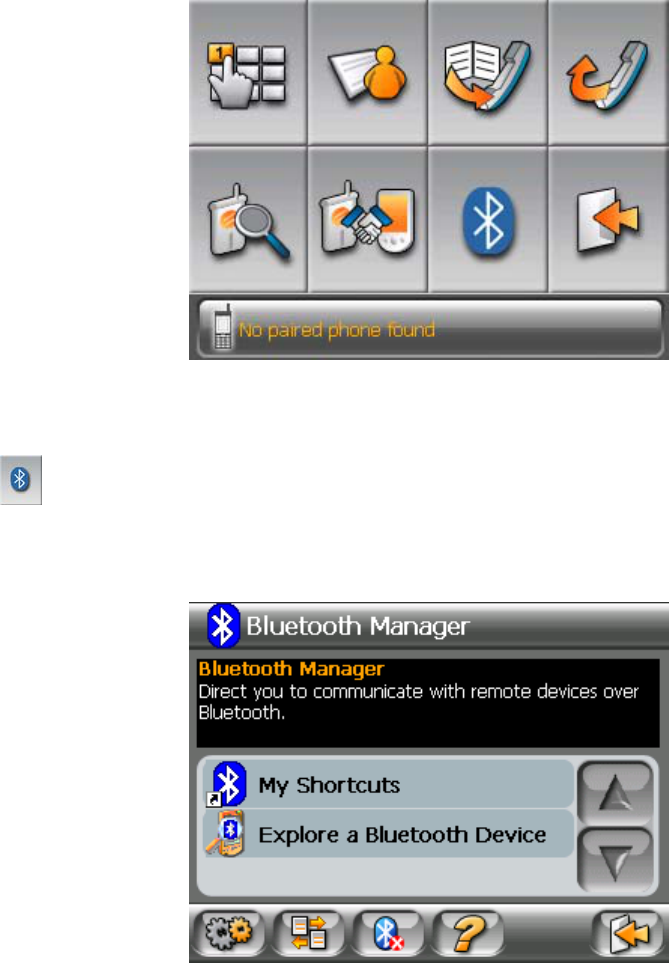
Chapter 9: Bluetooth
89
Figure 5~1
9.3.1 Tap in the main interface (Figure 5~1) to enter “Bluetooth Manager” window.
Figure 5~2
9.3.2 Tap “My Shortcuts” to explore the shortcut stored in “My Shortcuts”.
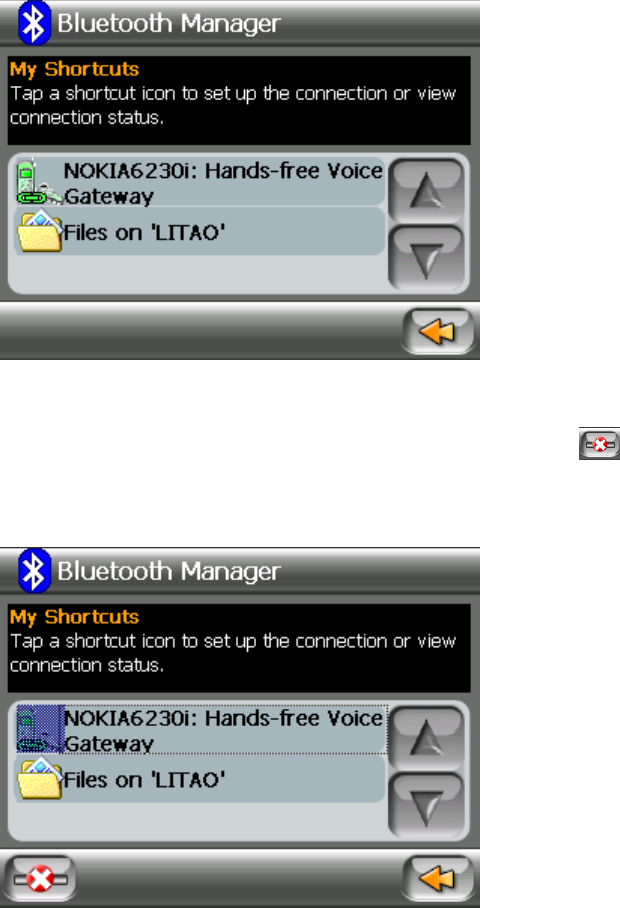
Chapter 9: Bluetooth
90
Figure 5~3
Note: If the connection is active, the color of the shortcut shall be green. Choose the shortcut and tap to disconnect the
connection.
Figure 5~4

Chapter 9: Bluetooth
91
Figure 5~5
• Tap to connect again.
• Tap to delete the shortcut.
• Tap to set the connection as the default connection.
• Tap to exit “My Shortcuts” window.
9.4 How to use Active Connections
The “Active Connections” shows the incoming connection. You can find the active connection in that window and
disconnect the connection.
Figure 6~1
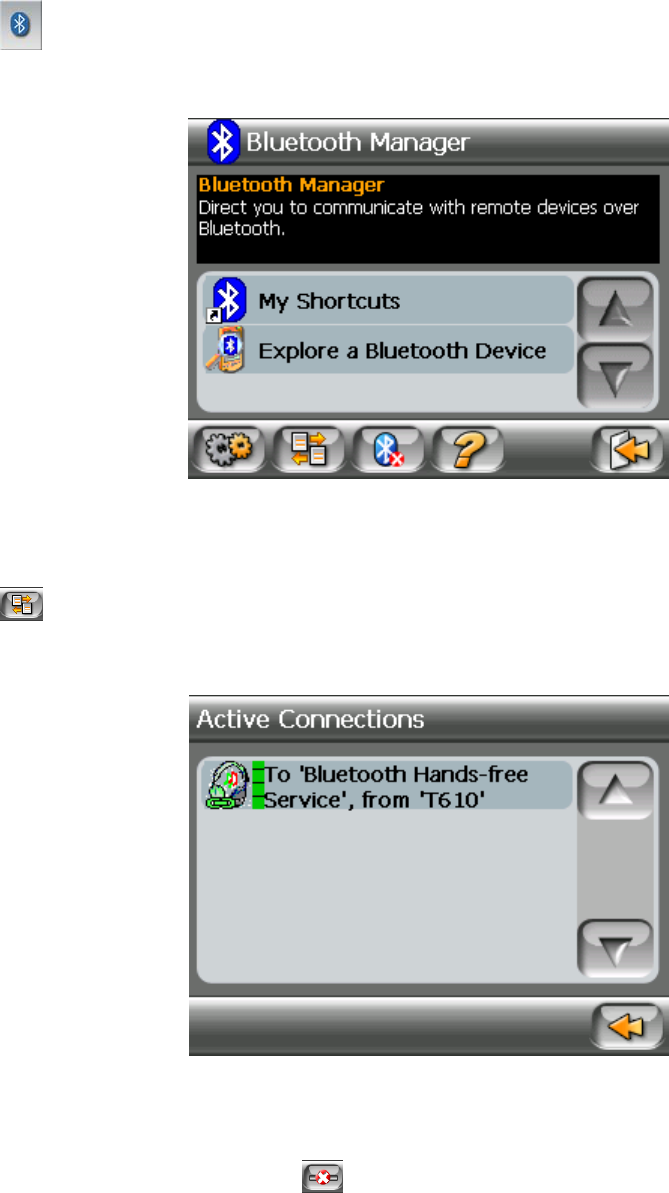
Chapter 9: Bluetooth
92
9.4.1 Tap in the main interface (Figure 6~1) to enter “Bluetooth Manager” window.
Figure 6~2
9.4.2 Tap in the main interface (Figure 6~1) to enter “Active Connections” window.
Figure 6~3
9.4.2.1 Choose a active connection, the shall display (Figure 6~4), and then you can tap this button to
disconnect the active connection.
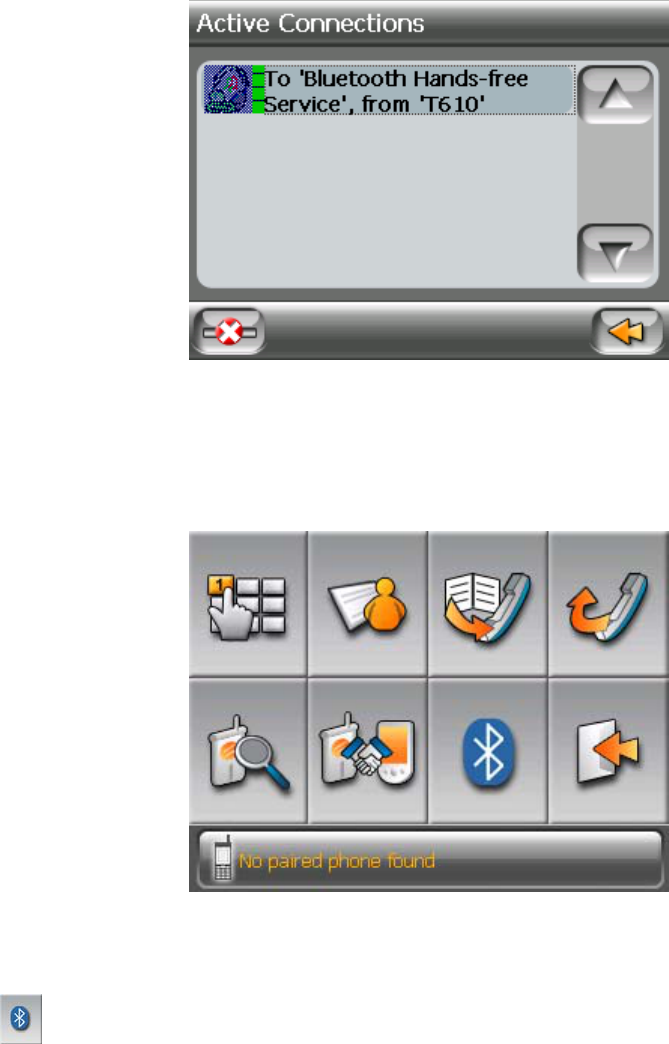
Chapter 9: Bluetooth
93
Figure 6~4
9.5 How to use Bluetooth Settings
Figure 7~1
9.5.1 Tap in the main interface (Figure 7~1) to enter “Bluetooth Manager” window.
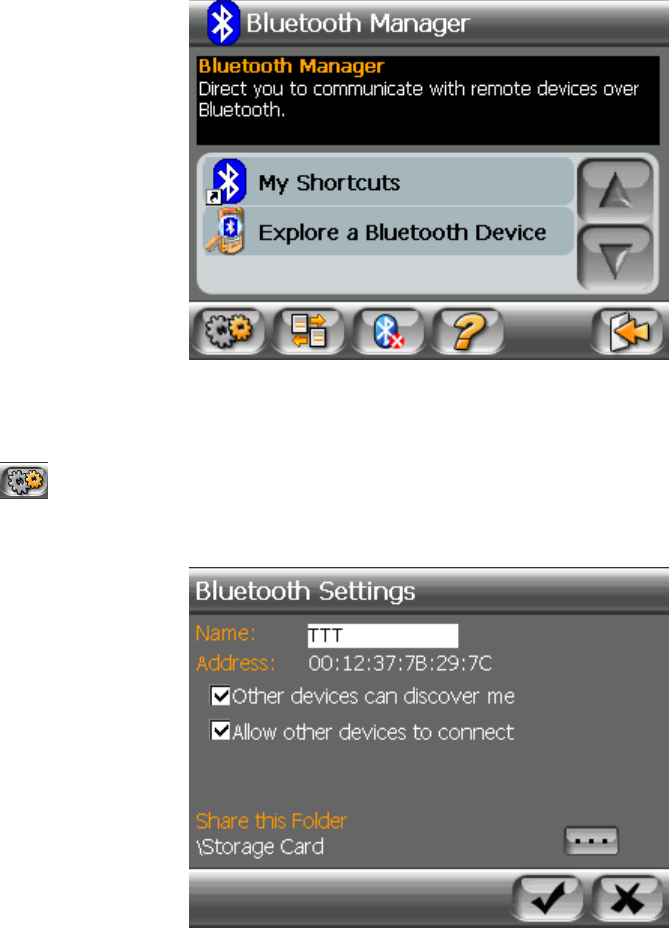
Chapter 9: Bluetooth
94
Figure 7~2
9.5.2 Tap to enter “Bluetooth Settings” window as below:
Figure 7~3
• Select the white box before “Other devices can discover me” so that other device can discover your Magellan RoadMate.
• Select the white box before “Allow other devices to connect” so that other devices can connect to your Magellan Road-
Mate.
9.5.3 Tap the name area, the “Device Name” change window shall pop up as below:
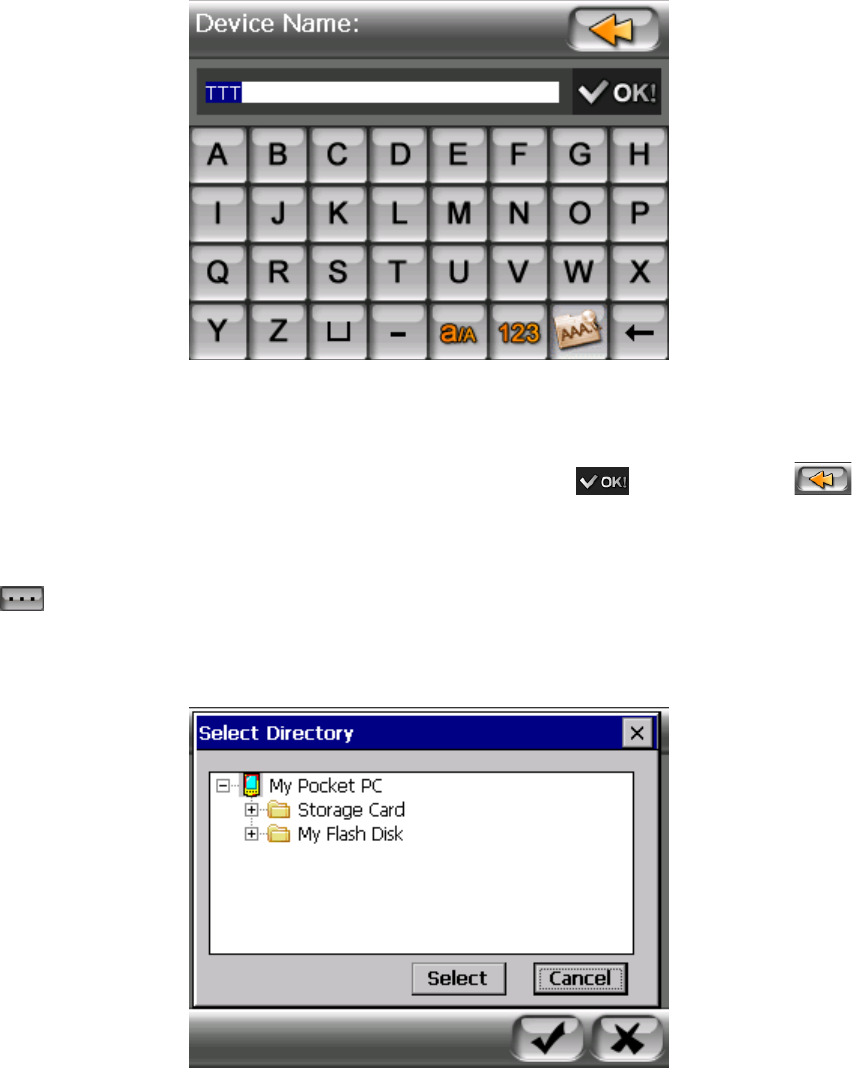
Chapter 9: Bluetooth
95
Figure 7~4
9.5.4 Input the new device name you want to change to, and tap to verify or tap to cancel.
9.5.5 Tap in the “Bluetooth Settings” (Figure 7~3) to set the share folder you want to use in
Bluetooth file transfer.
Figure 7~5
9.5.6 The default share folder is “My Flash Disk”. If you have inserted a memory card to your Magellan
RoadMate, there shall be a “Storage Card” directory in the directory list. Select the folder you want to
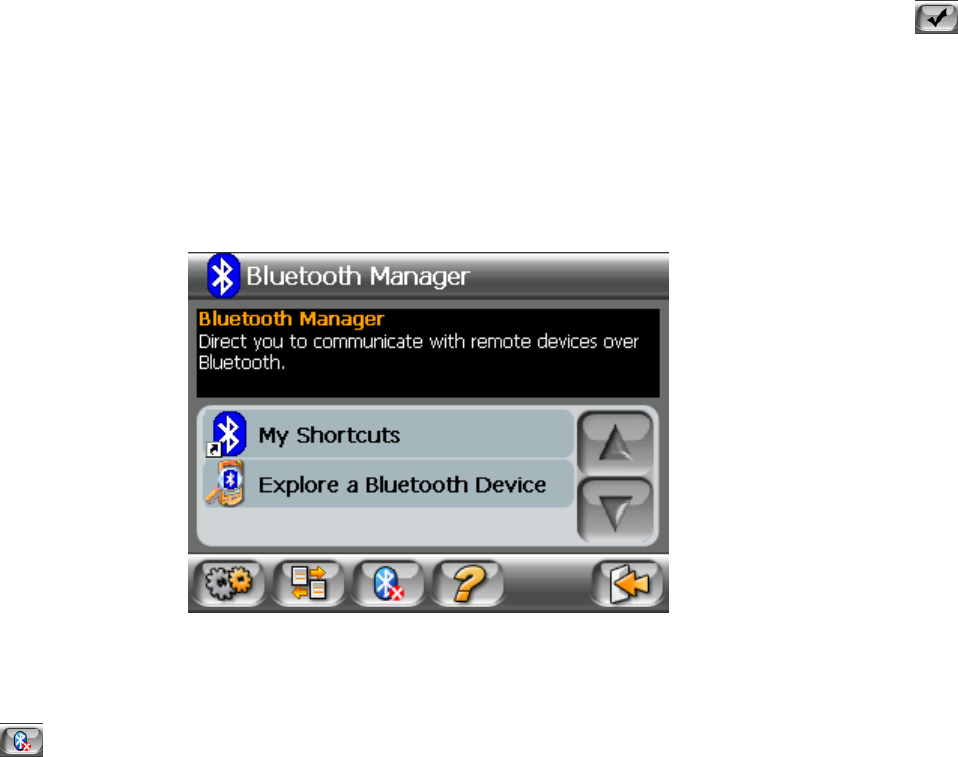
Chapter 9: Bluetooth
96
use in the Bluetooth file transfer, and tap the “Select” button to set the share folder or tap the “Cancel”
button to cancel the share folder change.
9.5.7 After setting the share folder, it shall back to “Bluetooth Setting” window (Figure 7~3), tap
to save your settings and go back to “Bluetooth Manager” window (Figure 7~2).
9.6 How to Exit
If you want to power off Bluetooth, what you need to do is like these steps as shown below:
Figure 8~1
9.6.1 Tap to power off the Bluetooth and go back the main interface.
Note: If your Magellan RoadMate is connected to other devices via Bluetooth wireless technology or other device connected
to your Magellan RoadMate via Bluetooth wireless technology, you need to disconnect the connection first; otherwise you
could not power off the Bluetooth.
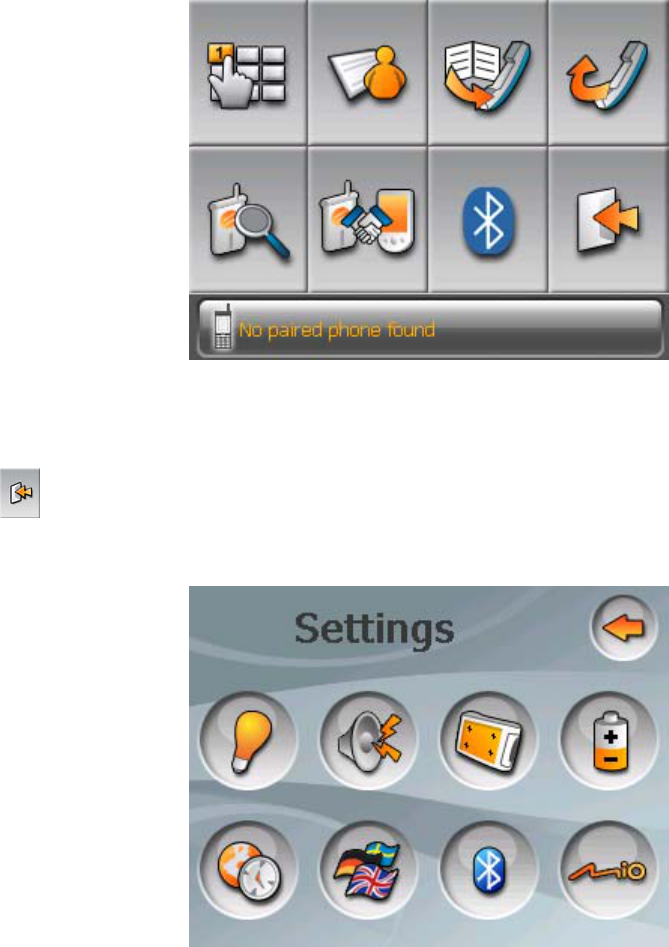
Chapter 9: Bluetooth
97
Figure 8~2
9.6.2 Tap to exit the main interface and go back to the “Settings” window.
Figure 8~3

98
Chapter 10: System Settings
The System Settings Menu contains system wide customization features which include:
Brightness, Power Management, Password, and Language.
To access these features, press the MENU key on the Magellan RoadMate 6000T and
select System Settings.
10.1 Brightness
To change how light the screen appears, select Brightness.
Use the right arrow to make the screen appear lighter, and use the left arrow make the
screen appear darker.
With On-battery dimming enabled, the screen will decrease in brightness by 20% to save
some battery power.
When you have finished, select OK to confirm or select ESC to cancel changes.
10.2 Power Management
The Power Management features enable you to customize the features that will conserve
battery power and display life. Select Power Management.
Select the time period to put the Magellan RoadMate 6000T in “sleep” mode.
Select to enable or disable turning the screen off when music is being played.
When you have finished, select OK to confirm or select ESC to cancel changes.
10.3 Password
10.3.1 Set Password
You can protect the Magellan RoadMate 6000T form unwanted use by enabling a
password. Select Password.
Select Set Password to enter a password. Use the keypad to enter the desired password.
When you have finished, select OK.
Re-enter the password to confirm. Use the keypad to re-enter the password exactly as you
entered it the first time. When you have finished, select OK.
Select OK to activate the password. To return to the System Settings menu without setting the password, select ESC.
Once the password is enabled, you will be required to enter it when the Magellan RoadMate 6000T is turned on or when it
wakes up from “sleep” mode.
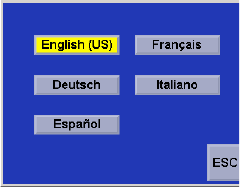
Chapter 10: System Settings
99
10.3.2 Change Password
Select Change Password. Use the keypad to enter the desired password. When you have finished, select OK.
Re-enter the password to confirm. Use the keypad to re-enter the password exactly as you entered it the first time. When you
have finished, select OK.
Select OK to activate the password. To return to the System Settings menu without setting the password, select ESC.
Once the password is enabled, you will be required to enter it when the Magellan RoadMate 6000T is turned on or when it
wakes up from “sleep” mode.
10.3.3 Delete Password
Select Delete Password and use the keyboard to enter the password.
A dialog box will apper asking you to confirm your selection. Select Yes.
10.4 Language
To change the language for the menu text and voice prompts for navigation, select
Language.
Select the desired language. A dialog box will appear asking you to confirm your selection.
Select Yes.
The Magellan RoadMate 6000T will restart itself with the new language enabled.

100
Chapter 11: System Status
The System Status menu give you further options to check the performance of your Magellan RoadMate 6000T.
11.1 Product Information
Select Product Information to show the current application software versions. Also, the
current hardware and firmware versions will be displayed.
11.2 User Storage
Select User Storage to display the available space of the memory card if it is installed..
11.3 Diagnostics
Diagnostics enables you to test key performance elements of the Magellan RoadMate
6000T
11.3.1 Audio Test
The Audio Test will check the performance of the built-in speaker.
11.3.2 Touchscreen Test
The Touchscreen test will enable you to recalibrate the touchscreen should it not be
tracking properly.
11.3.3 Keypad Test
The Keypad test will determine if the buttons on the Magellan RoadMate 6000T are functioning.
11.3.4 Video Test
The Video test will test to determine if the screen is displaying colors properly.
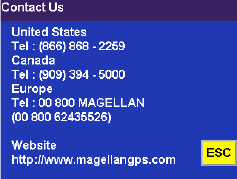
Chapter 11: System Status
101
11.4 Contact Us
If you experience problems using your Magellan RoadMate 6000T, you can contact us at the
numbers displayed.
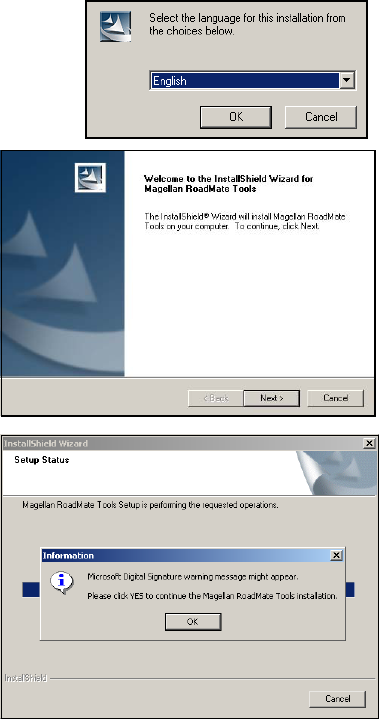
102
Chapter 12: Magellan RoadMate Tools Installation
The Magellan RoadMate Tools application enables you to create custom POI’s and load them onto your Magellan RoadMate
6000T. Additionally, you can load pictures and music onto an SD or MMC card (sold separately) to view or play anytime. See
“Using Removable Memory Cards” on page 9.
12.1 Installing the Software
Insert the Magellan RoadMate Tools PC Application CD into your PC’s CD drive.
The setup application will begin automatically. If it does not, browse your computer’s CD drive and double-click on the
setup.exe file.
Select a default language for the Application.
The Welcome screen will appear to begin the installation process.
Choose a destination for the application. Select Next to use the default
location, or select Browse to choose a custom destination.
Next, choose a Program Folder to place the application icons.
The Magellan RoadMate Tools software will be installed. After it has finished
installing, a dialog box pertaining to Microsoft DIgital Signatures may appear,
select OK
When it has finished, to can have the installer launch the application
automatically, or deselect to exit without launching the application. Select
Finish.
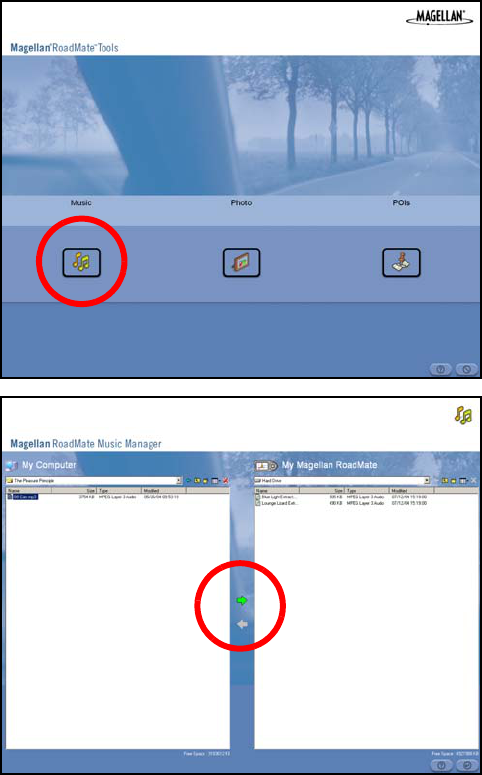
103
Chapter 13: Magellan RoadMate Music Manager
The Magellan RoadMate Music Manager enables you to transfer song files in MP3 or WMA format from your computer to an
optional memory card (see “Using Removable Memory Cards” on page 9) installed in your Magellan RoadMate 6000T. The
amount of music you can load depends on the size of the card.
Insert the memory card into the memory card slot as show on page 9. Turn on your Magellan RoadMate 6000T by pressing
and holding the Power button for approximately 2-3 seconds if in sleep mode. (Ten seconds if not in sleep mode.) When
the Warning screen appears, insert the small end of the USB cable into the USB port on your Magellan RoadMate 6000T
and the large end into an available USB port on your computer.
Launch the Magellan RoadMate Tools application. From the
Magellan RoadMate Tools screen, click on Music.
The left side of the window shows the contents of your computer
and the right side of the window shows the contents of the
memory card installed in your Magellan RoadMate 6000T.
Locate the song files you wish to load. When you have selected a
file, the Transfer arrow will turn green. Click on the Transfer
arrow to copy the file(s) to the memory card.
In the same way, if you have loaded song files onto a memory card from another computer, you can copy the files from the
memory card to your computer.
When you have finished copying files, remove the USB cable from the Magellan RoadMate 6000T.
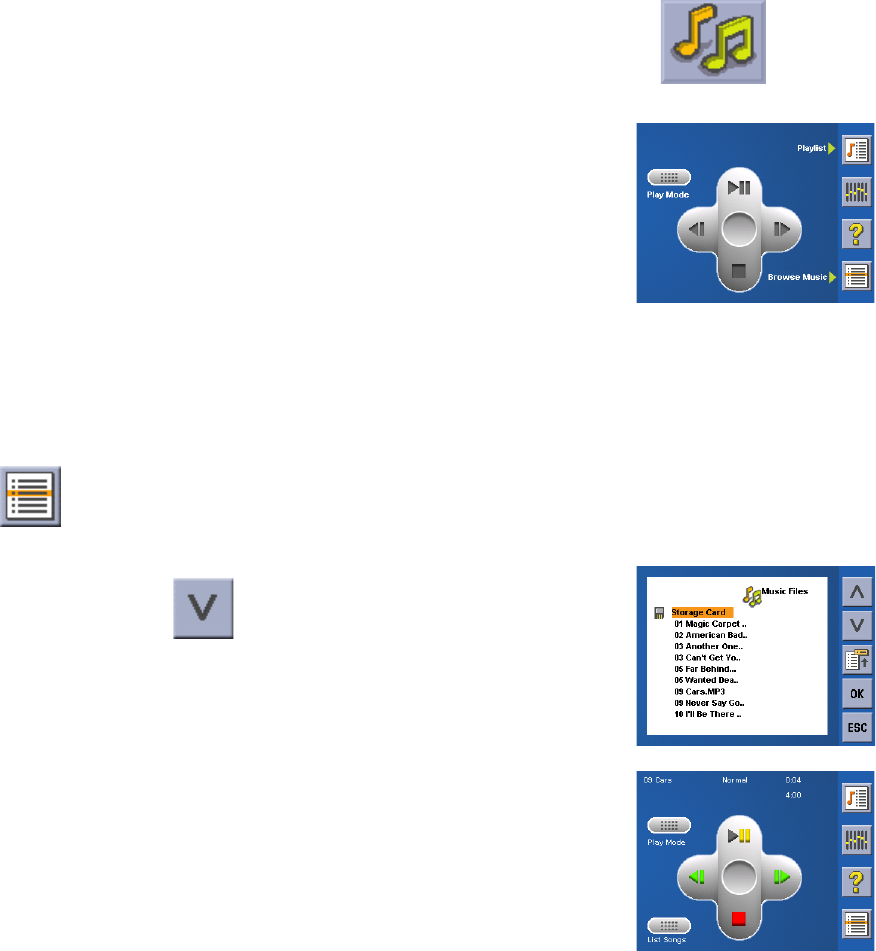
104
Chapter 14: Music Player
The Magellan RoadMate 6000T Music Player enables you to play music files in MP3, or WMA format, stored on an optional
memory card installed in your Magellan RoadMate 6000T. If you have not already done so, you must install the Magellan
RoadMate Tools application (page 102) and transfer files onto the card using the Magellan RoadMate Music Manager
(page 103). You can also use a memory card that has been preloaded from a card reader.
Press the MENU key on the Magellan RoadMate 6000T (see page 5) and select the Music Player. .
The Music Player control pad will appear.
14.1 Single Song Play
Select Browse Music
Use the Navigation key or the Down arrow to select the song file you wish to play and
press OK.
The song will begin playing automatically.
At the top of the screen is displayed the name of the song, the artist (if available), the selected
play mode, the elapsed time, and the song duration.
Press the Play/Pause button to suspend song play. To resume song play, press the Play/Pause
button again.
Press the Stop button to stop song play. Once a song has been stopped, pressing the Play/
Pause button will start the song from the beginning.
14.2 Multiple Song Play
Multiple song play enables you to create a “playlist”. A playlist consists of one or more songs in a group that can be played
continuously.

Chapter 14: Music Player
105
Select Playlist
The Playlist menu will appear. To exit from the playlist menu, select ESC.
14.2.1 Play
To hear a previously created playlist, select Play.
Use the Up or Down arrow to select the desired playlist. Select OK.
The songs will begin playing automatically in order.
14.2.2 Create
To make a new playlist, select Create.
Use the backspace key (<-) to erase the default name; and the keypad to enter a new name for your playlist. When you have
finished, select OK.
The next screen to appear shows the song files stored on the memory card on the left side, and the playlist on the right side.
Use the arrow buttons on the left side of the screen to highlight the Music folder and then, select List Files.
Use the arrow buttons to highlight the song files you wish to add to the playlist. Select Add to Playlist (right arrow) to add
the highlighted song to the playlist.
Continue adding files to the playlist. When you have finished, select OK.
14.2.3 Modify
Modify enables you to add or remove songs from the selected playlist. Select Modify.
To remove a song from the playlist, use the arrow keys on the right side of the screen to highlight the desired song and then
select Remove From Playlist (left arrow).
Use the arrow buttons on the left side of the screen to highlight the song files you wish to add to the playlist. Select Add to
Playlist (right arrow) to add the highlighted song to the playlist.
Continue adding files to the playlist. When you have finished, select OK.
14.2.4 Delete
To remove a playlist, select Delete.
Select the playlist you wish to delete and select OK.
A dialog box will appear asking to confirm your selection. Select Yes to delete the playlist.
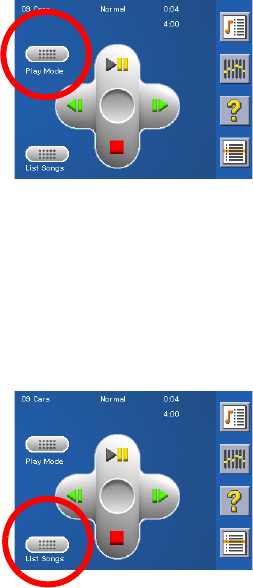
Chapter 14: Music Player
106
14.2.5 Rename
If you want to change the name of a playlist, select Rename.
Select the playlist you wish to rename and then, select OK.
Use the backspace key (<-) to erase the name; and the keypad to enter a new name for your playlist. When you have
finished, select OK.
14.3 Play Mode
While in single song play, select Play Mode for song play options.
Repeat All - Repeats all the songs in the current playlist starting at the beginning of the order.
This function works only if there are two or more songs in the playlist.
Repeat - repeats the song that is currently playing.
Preview - Plays the first five seconds of each song in the current playlist.
Normal - Plays all songs in the current playlist in order.
Random - Plays the songs in the current playlist in random order.
14.4 List Songs
Select List Songs to view the current playlist.
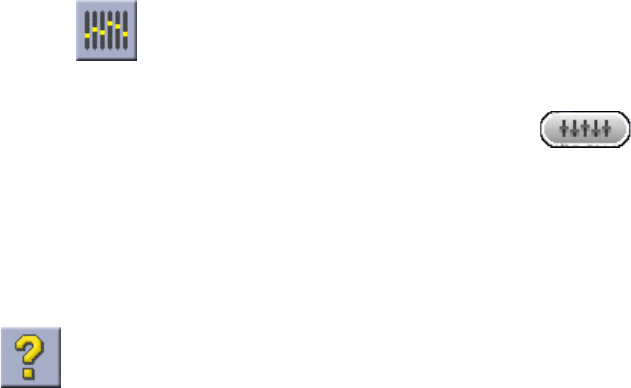
Chapter 14: Music Player
107
14.5 Equalizer
The Equalizer provides advanced sound options so you can customize the quality of the playback. The equalizer will only be
available for MP3 format sound files. Select an equalizer preset from the following preconfigured options: Default (flat),
Jazz, Classical, Rock, Techno, Dance Hall, Live, Full Bass, Full Treble, and Full Bass & Treble. You are not able to however,
manually set the equalizer.
Select the Equalizer
Select the equalizer preset by pressing the button at the top of the screen .
When you are satisfied with your selection, select OK. To exit without setting the equalizer, select ESC.
14.6 Help
Select Help for descriptions of the Music Player buttons.
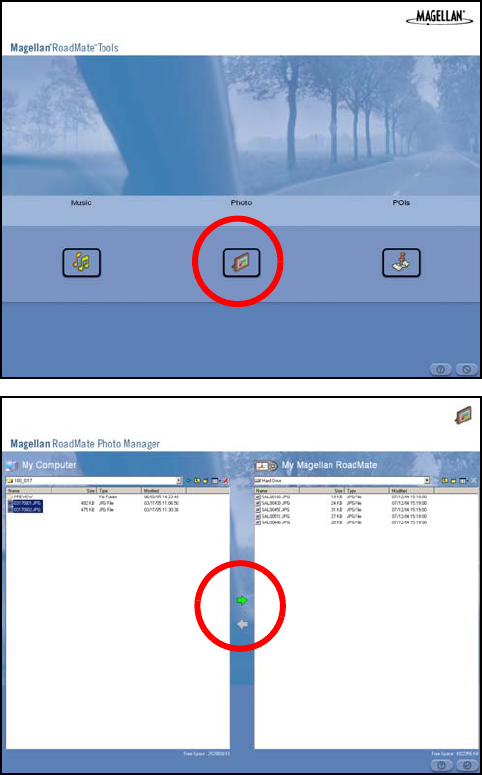
108
Chapter 15: Magellan RoadMate Photo Manager
The Magellan RoadMate Photo Manager enables you to transfer image files in multiple formats from your computer to an
optional memory card (see “Using Removable Memory Cards” on page 9) installed in your Magellan RoadMate 6000T. The
number of images you can load depends on the size of the card. You can also use a memory card that has had images
preloaded using a card reader.
Insert the memory card into the memory card slot as show on page 9. Turn on your Magellan RoadMate 6000T by pressing
and holding the Power button for approximately 2-3 seconds (Ten seconds if the Magellan RoadMate 6000T is not in sleep
mode.) When the Warning screen appears, insert the small end of the USB cable into the USB port on your Magellan
RoadMate 6000T, and the large end into an available USB port on your computer.
Launch the Magellan RoadMate Tools application. From the
Magellan RoadMate Tools screen, click on Photo.
The left side of the window shows the contents of your computer
and the right side of the window shows the contents of the
memory card installed in your Magellan RoadMate 6000T.
Locate the image files you wish to load. When you have selected
a file, the Transfer arrow will turn green. Click on the Transfer
arrow to copy the file(s) to the memory card.
In the same way, if you have loaded image files onto a memory card from another computer, you can copy the files from the
card to your computer.
When you have finished copying files, remove the USB cable from the Magellan RoadMate 6000T.
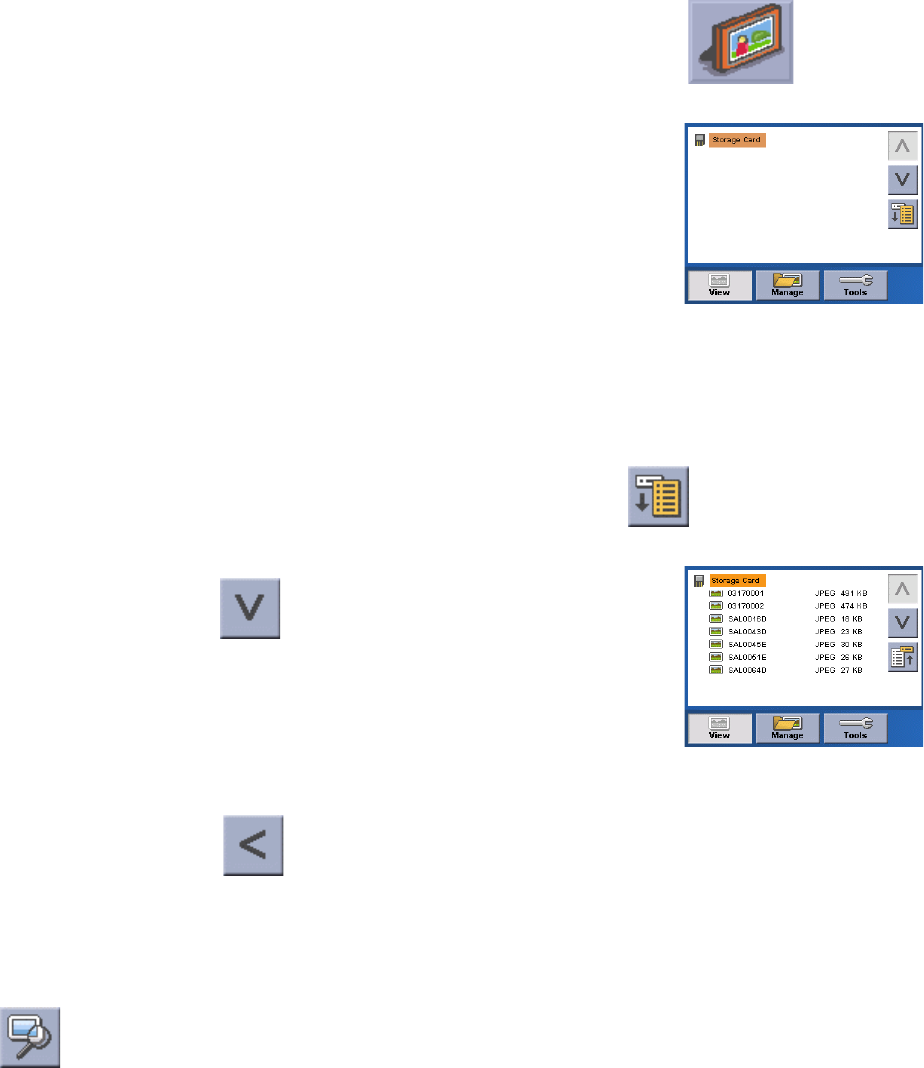
109
Chapter 16: Photo Viewer
The Magellan RoadMate Photo Viewer enables you to view image files in JPG and BMP format, stored on an optional memory
card installed in your Magellan RoadMate 6000T. If you have not already done so, you must install the Magellan RoadMate
Tools application (page 102) and transfer files onto the card using the Magellan RoadMate Photo Manager (page 103).
Press the MENU key on the Magellan RoadMate 6000T (see page 5). Select the Photo Viewer .
The Photo Viewer screen will appear. The Photo viewer will show the contents of the SD or MMC
card installed in your Magellan RoadMate 6000T..
16.1 View Single Photo
The next screen to appear shows the file structure of the memory card. Select List Files .
Use the Navigation key or the Down arrow to highlight the photo you wish to view and
select View.
While viewing the image, double clicking on the image (that is tapping twice on the screen) will
show the image in full screen. You can then cycle through the images by pressing left or right
on the Navigation key.
16.1.1 Previous Image (left arrow)
Press the right arrow button to view the previous image in the folder. This button is grayed out (not functional) when viewing
the first image in the folder.
16.1.2 Zoom
Press the Zoom button to reduce or enlarge the current photo. The top of the zoom menu shows the current zoom level.
Select another zoom level from the list of presets. Select Best Fit to adjust the zoom to fit within the display boundaries;
select Actual Size to display the image at 100%; select 25% to 150% to reduce or enlarge the image to the preset level.
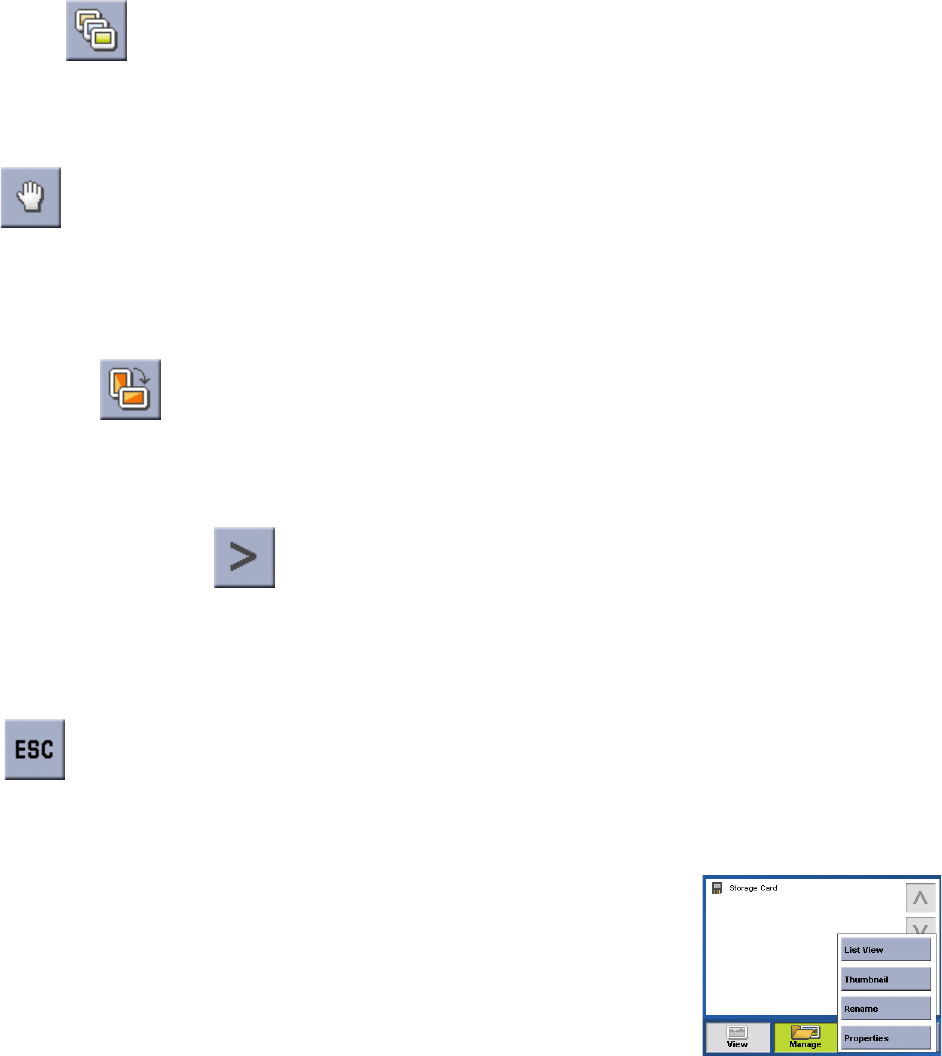
Chapter 16: Photo Viewer
110
16.1.3 Slideshow
Press the Slideshow button to cycle through all the photos in the Pictures folder automatically.
16.1.4 Pan
If you enlarge an image beyond the screen boundaries, press the Pan button to enable image scrolling. While enabled, you
can drag the image in any direction to view other areas of the image. Press the Pan button again to disable Pan mode.
16.1.5 Rotate Image
Press the Rotate Image button to rotate the image 90° counterclockwise, 90° clockwise, or 180°.
16.1.6 Next Image (right arrow)
Press the right arrow button to view the next image in the folder. This button is grayed out (not functional) when viewing the
last image in the folder.
16.1.7 ESC
Press ESC to return to the folder list.
16.2 Manage Photos
16.2.1 List View
Press List view to show the files in a hierarchal list view.
16.2.2 Thumbnail
Press Thumbnail to show the files as thumbnails.
16.2.3 Rename
To change the name of the selected file or folder, press Rename.
Use the backspace key (<-) to erase the name; and the keypad to enter a new name for your file. When you have finished,
select OK.
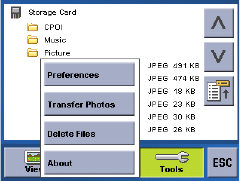
Chapter 16: Photo Viewer
111
16.2.4 Properties
To view information on the selected file or folder, press Properties. A thumbnail of the image will be displayed along with the
width and height in pixels, the size, and the format (image type). When viewing the properties for folders, width, height, and
format are not shown. Size shown is the combined size of all images in the selected folder.
When you are finished viewing the properties, select OK.
16.3 Tools
16.3.1 Preferences
General – The General preferences, you can set the default file view to either thumbnail or file
list view.
Slideshow – The slideshow preferences enable you to set the view properties, the sequence of
photos, the transition between photos, and the duration between photos.
Background – The background preferences enable you to set the color of the background behind the photo being viewed.
16.3.2 Delete Files
Use the arrow keys to select the file or folder you wish to delete. Press the Delete button (trash can).
A dialog box will appear asking to confirm your selection. Select Yes to delete the file.
16.3.3 About
This option will display the current version of the Photo Viewer software.
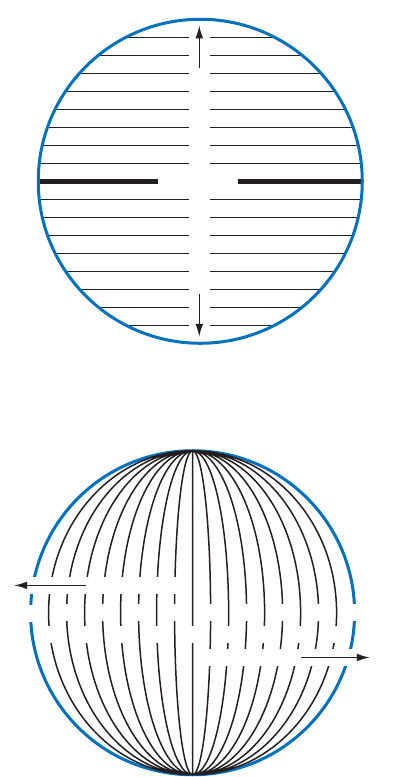
112
Chapter 17: Magellan RoadMate POI Manager
The Magellan RoadMate POI Manager enables you to transfer custom points of interest files from your computer to your
Magellan RoadMate 6000T.
Before we add any custom POI’s to the Magellan RoadMate 6000T, you should understand how the POI Manager plots POIs.
17.1 Latitude
Latitude can be expressed by dividing Earth into horizontal segments
totalling 180 degrees. Starting at the Equator, or zero degrees Latitude,
lines (or Parallels) are drawn in 10-degree increments 90 degrees to the
north and 90 degrees to the south. If your location is below the Equator,
you are at a South Latitude.
17.2 Longitude
Conversely, longitude lines can be expressed by dividing Earth into vertical
segments totalling 360 degrees. Starting at the Prime Meridian (which is
The Royal Observatory in Greenwich, England), or zero degrees Longitude,
lines are drawn in 10-degree increments 180 degrees to the West and 180
degrees to the East. If your location is on the western hemisphere, you are
at a West Longitude.
Additionally, to narrow down your location further, each 10-degree segment
is divided into 60 smaller segments called minutes and, still further, each
minute is divided into 60 segments called seconds.
To express this in coordinates, the city of Los Angeles is located at 34°
(degrees) 03’ (minutes) and 08 (seconds) North of the Equator, and 118°
(degrees) 14’ (minutes) and 42 (seconds) West of the Prime Meridian.
North Latitude
South Latitude
0°
10°
20°
30°
40°
50°
60°
70°
80°
90° (North Pole)
0°
10°
20°
30°
40°
50°
60°
70°
80°
90° (South Pole)
Equator
90°
West Longitude
East Longitude
70° 50° 30° 10° 10° 30° 50° 70° 90°
80° 60° 40° 20° 0° 20° 40° 60° 80°
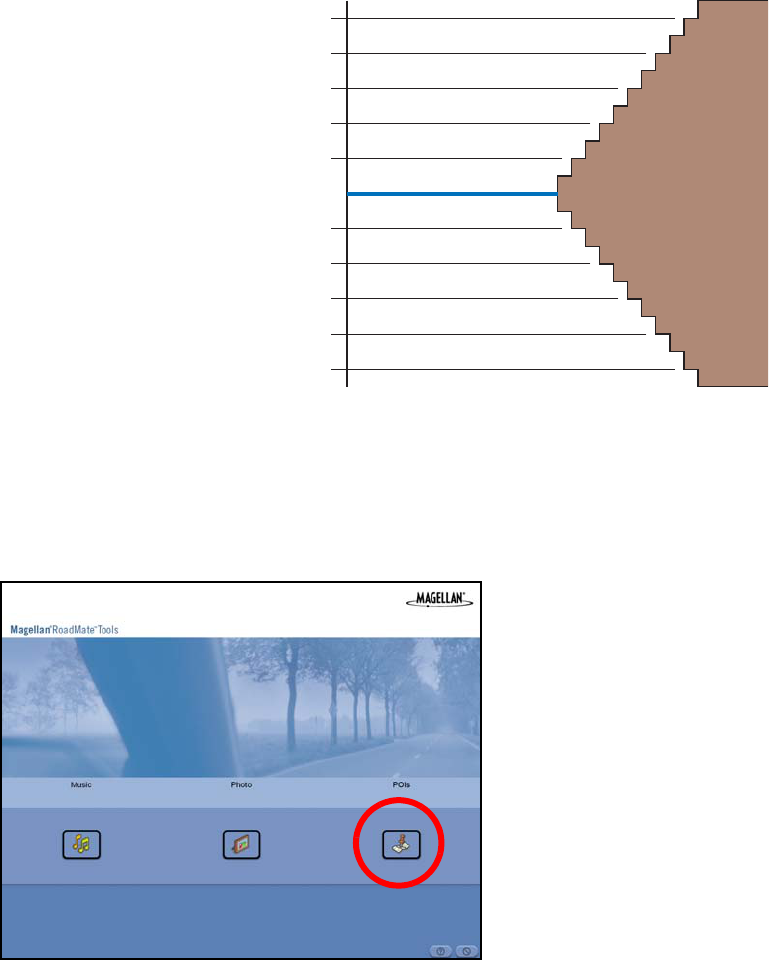
Chapter 17: Magellan RoadMate POI Manager
113
17.3 Altitude
Each location can also have an Altitude. Altitude is expressed
by how far the point is above or below the level of the ocean, or
Sea Level. For example, Los Angeles, California is about 300
feet above sea level. Death Valley, California is about 270 feet
below sea level.
Turn on your Magellan RoadMate 6000T by pressing and holding the Power button for approximately 2-3 seconds, 10
seconds if not in sleep mode (see “Top View” on page 6). When the Warning screen appears, insert the small end of the
USB cable into the USB port on your Magellan RoadMate 6000T, and the large end into an available USB port on your
computer.
Launch the Magellan RoadMate Tools application. From the Magellan RoadMate Tools screen, click on POI.
The left side of the window shows the contents of your computer and the right side of the window shows the contents of the
Magellan RoadMate 6000T.
17.4 Opening a POI File
When you start the POI Manager the contents of your “My POI’s” folder will be displayed. This is the default location for
storing custom POI files.
Sea Level 0’
20’ Above
40’ Above
60’ Above
80’ Above
100’ Above
100’ Below
80’ Below
60’ Below
40’ Below
20’ Below
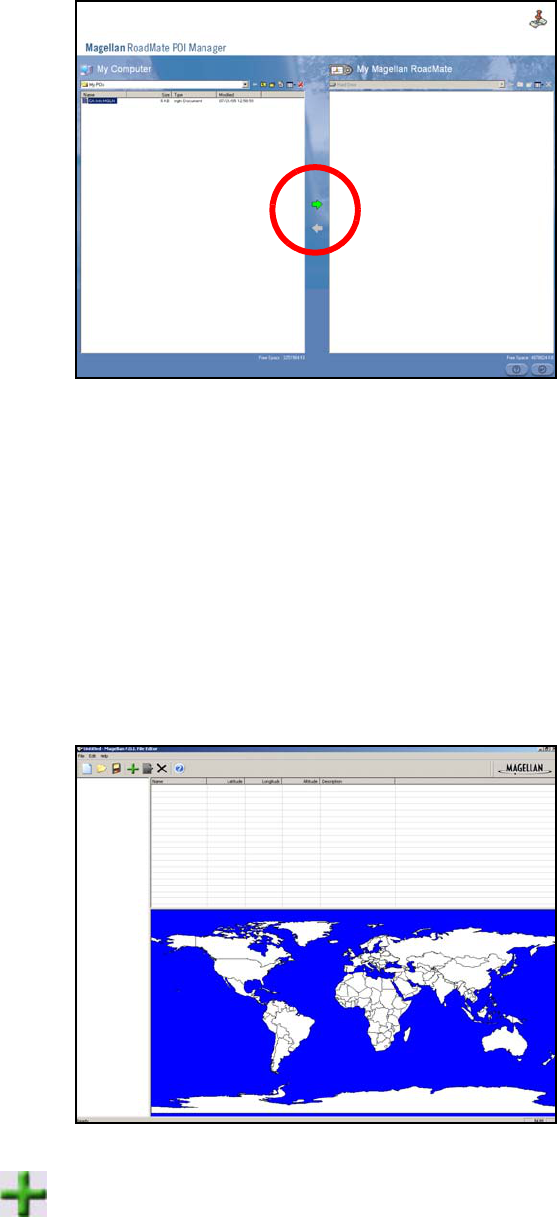
Chapter 17: Magellan RoadMate POI Manager
114
Locate the POI files you wish to load. When you have selected a file, the Copy To Unit arrow will turn green. Click on the
arrow to copy the file to your Magellan RoadMate 6000T.
When you have finished copying files, remove the USB cable from the Magellan RoadMate 6000T.
17.5 Creating a New POI FIle
There are two ways to create a POI file. You can either add POI’s individually, or you can import a character delimited file
containing the information need to plot the POI’s. To plot a POI, each item must have a name, longitude, and latitude.
Longitude and latitude must be in decimal format.
17.6 Adding Individual POI’s
Click on the New POI File Button to launch the POI Editor.
Click on the Add button .
Enter the Name, the Latitude, and the Longitude. The Altitude and Description fields are optional.
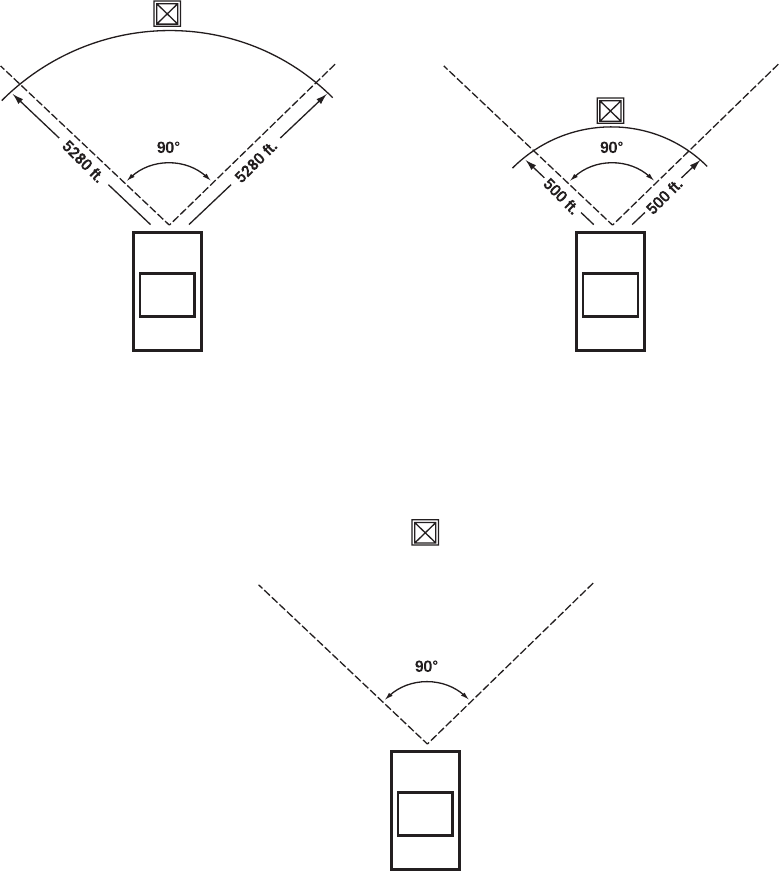
Chapter 17: Magellan RoadMate POI Manager
115
Select the Category field and select New. A dialog box will appear to create a new POI category. Enter the Name and assign
an Image (icon) for the POI. The Description field is optional.
The Alert feature is an audible alarm that lets you know when you are within a certain distance from the POI. You can set an
initial reminder (Distance 1), a secondary reminder (Distance 2).
Select your preferred unit or measure (Meters or Feet).
The Detection angle sets the range of alert in degrees from the POI.
Select Activate alert for this category to enable the alert settings.
When you have finished, select OK.
Distance 1 Distance 2

Chapter 17: Magellan RoadMate POI Manager
116
17.7 Importing a Data FIle
The POI Manager software supports ASCII file format (.ASC,.CSV,.TXT); GPS Exchange file format (.GPS,.XML); Magellan
Waypoint file format (.WPT,.RTE); and Garmin PCX5 Waypoint file format (.WPT,.RTE).
Click on the Open button .
Select the file you wish to import and click Open.
Start by choosing which line in the data file to start importing data. If your data file has a header row, this row will generate
an error so you should start at line two or below.
Next, choose how the data is separated and click on Next.
You now need to define the data columns. Click on the pull down menu and assign a field name to the appropriate column.
Click on Finish.
Click on The Save POI file button. Assign a name to your file and click on Save.
Close the POI File Editor. Select the POI file you just created and click on the transfer button (right arrow) to upload the file
to your Magellan RoadMate 6000T.
See page 55 for information on accessing custom POIs on your Magellan RoadMate 6000T.
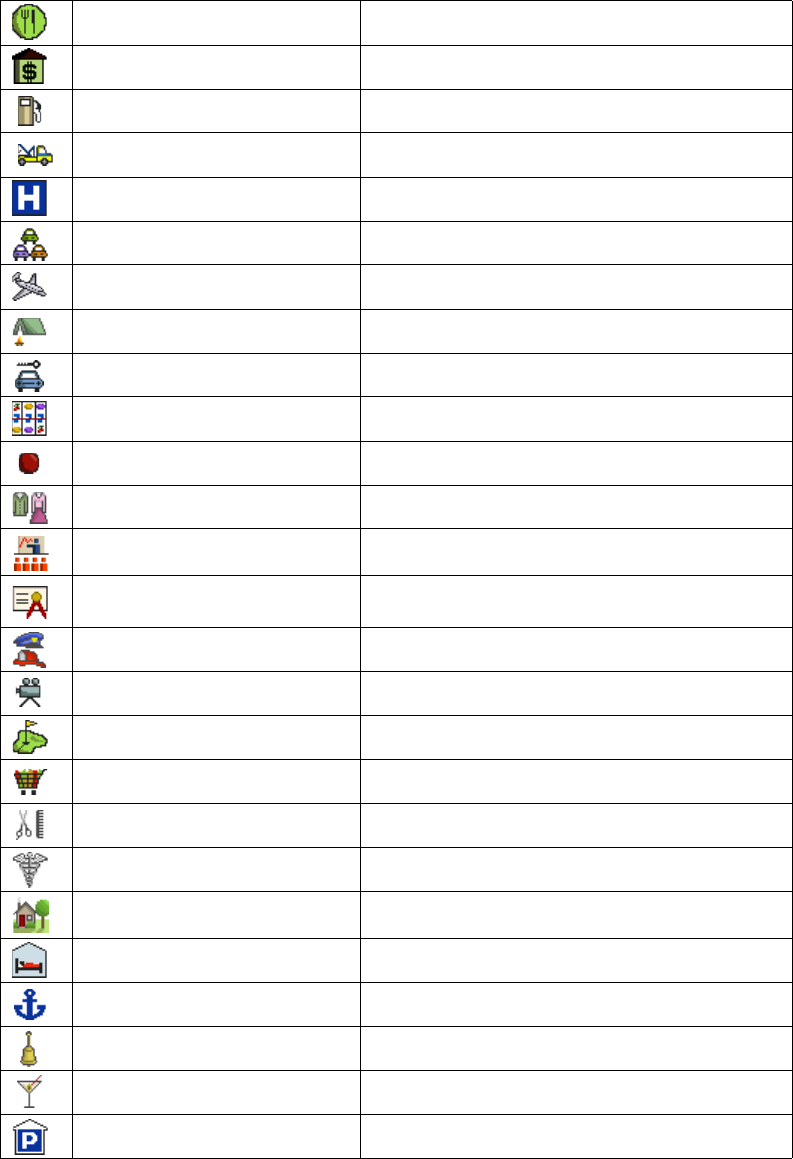
117
Appendix
POI Categories
The Magellan RoadMate 6000T POI database has 37 different categories. The icons will appear on the Map screen (if
enabled):
Restaurant Fast food, diners, and food marts
Bank/ATM Most financial services
Gas Station Most fuel services
Roadside Assistance Towing companies
Hospital/Polyclinic Most medical services
Vehicle Services Repair shops, tire stores, and oil changes
Airport International and Municipal airports
Camping & RV Campgrounds, camping areas, and RV parks
Car Rental Car rental companies
Casino Gambling venues
City Center The geographical center of a selected city
Clothing Clothing retail stores
Convention Center Major Convention Centers
Education Schools, Colleges, and other learning
institutions
Emergency Services Police, FIre, and Emergency Rooms
Entertainment Movie theaters, live performance venues
Golf Course Private and public courses
Grocery Store Major chains and local markets
Hair & Beauty Salons and beauty parlors
Health Care Doctors’ offices and pharmacies
Home & Garden Nurseries and do-it-yourself centers
Hotel or Motel Most overnight stay locations
Marina Docks and harbors
Misc. Services Other services not categorized
Nightlife Dance halls, pubs, nightclubs
Open Parking Area Parking lots and garages
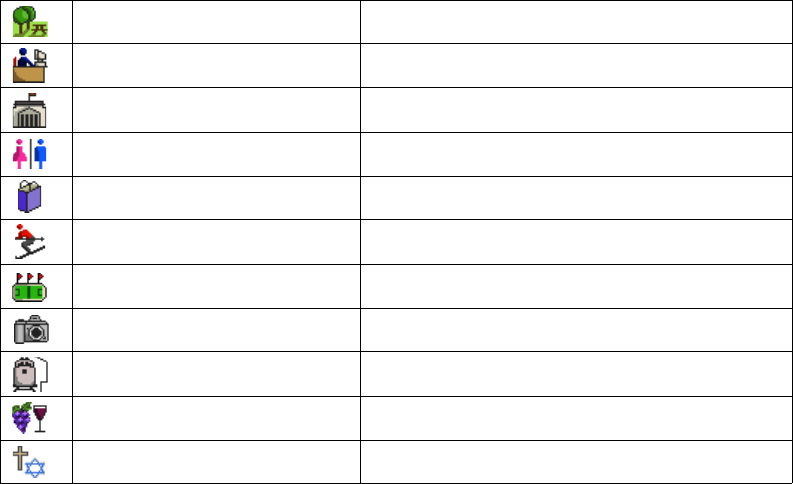
Appendix
118
When selecting restaurants, you can further narrow the search by cuisine type such as French, Italian, Greek, Mexican, etc.
Parks County, regional, and local parks
Professional Services Business office locations
Public Buildings Libraries, museums, and government buildings
Rest Area Rest stops along major highways
Shopping Malls and other retail stores
Ski Resorts Most major ski resorts
Sports & Recreation Stadiums, parks, lakes
Tourist Attraction Places most visited by tourists
Transportation Bus and train stations
Winery Vinyards and tasting locations
Worship Churches, temples, mosques
Appendix
119
Specifications
DImensions: 3.8" x 4.8" x 1.4"
9.6cm x 12.2cm x 3.5cm
Weight: 8.64 oz.
245 g
Display: 3.5” color touch screen display, 2.11” x 2.81” (53.64mm x 71.52mm)
Screen Resolution: 320 x 240 QVGA; 64,000 colors
Accepted Card Media: Secure Digital (SD) or Multimedia Card (MMC)
Audio: Integrated Speaker with integrated stereo headphone jack
GPS Antenna: Integrated with optional external antenna connection
Battery: 2100mA LI-ION
USB Interface:1.0
Operating Temperature: 32°F to 104°F
0°C to +40°C
Storage Temperature: -4°F to 158°F
-20°C to +70°C
Humidity: 50% ± 20% ambient room
PC Requirements
• IBM Compatible PC, Pentium or higher
• Microsoft ® WIndows® 2000 or XP
•128 MB RAM
• CD Drive for Software Installation
• DVD Drive for Map Upgrades
• USB Port

Appendix
120
GPS Status Screen
GPS STATUS Screen Structure-first page
It is ordered by the channel number from 1 to 12.
Where:
d1: Satellite PRN number, with “e” or “E” to the right means got ephemeris data, “v” or “V” to the right means got verified
ephemeris data (double check). “E” or “V” also means got satellite time for this channel.
d2: Azimuth, in degrees
d3: Elevation angle, in degrees
d4: SNR (signal to noise ratio), it is ratio-Hz, not dB unit
c1: U – Used for position fix, U – Not used for position fix
Bad fix code
0 PVT_OK :good fix
2 ILLEGAL_ALT: illegal altitude < -10km or > 17.5km
4 POSITION_JUMP: too big position jump between two epoch (300 miles)
5 ILLEGAL_VELOCITY_OR_ALT: max velocity 951mile
7 TOO_BIG_ACCELERATION max 15m around 1.5g
8 TOO_SMALL_ALTITUDE -10000 m
9 TOO_BIG_ALTITUDE 17,500 m
10 TOO_BIG_PDOP max PDOP 50
11 SATS_BELOW_MASK_ANGLE satellite elevation angle is below mask angle
16 ILL_DEFINED_3D_MATRIX 3X3 matrix can not be inverted in 3D fix
CH PRN AZ EL SNR U/N
01 d1 d2 d3 d4 c1
02 d1 d2 d3 d4 c1
03 d1 d2 d3 d4 c1
04 d1 d2 d3 d4 c1
05 d1 d2 d3 d4 c1
06 d1 d2 d3 d4 c1
07 d1 d2 d3 d4 c1
08 d1 d2 d3 d4 c1
09 d1 d2 d3 d4 c1
10 d1 d2 d3 d4 c1
11 d1 d2 d3 d4 c1
12 d1 d2 d3 d4 c1
13 d1 d2 d3 d4 c1
14 d1 d2 d3 d4 c1
Appendix
121
17 ILL_DEFINED_2D_MATRIX 2X2 matrix can not be inverted in 2D fix
20 NO_SAT_TIME no satellite time
23 NOT_ENOUGH_SATS no enough satellite for 2D or 3D fix
24 CANNOT_SELECT_FIX_TYPE
30 VELOCITY_2D_ONLY 2 satellite fix only for velocity, no position fix
31 BAD_VELOCITY_PDOP 50 too big pdop for velocity
32 TOO_MANY_SATS_FOR_2D_VEL there are 4 or more satellites, but 2D fix provided
51 WRONG_NUMSAT number of satellite for fix > 12 or less 2
56 LOOP_3D_NOT_CONVERGING 3D initial fix is not convergent
57 MILLISECOND_ERROR millisecond jump happened
58 LOOP_2D_NOT_CONVERGING 2Dinitial fix is not convergent
59 BAD_RANGE_CHITEST; range post-fix residuals chi-test failed
60 BAD_DOPPLER_CHITEST doppler post-fix residuals chi-test failed
61 OSC_DRIFT_ERR too much clock drift 60HZ for XO, 7.5HZ for TCXO
62 BAD_DOPPLER_ERR too big Doppler errors 4m/s
63 BIG_RANGE_RESID 110m/40m depend on virtual ttagl/ DGPS factors
64 BIG_DOPPLER_RESID 0.7m/s
65 HUGE_RANGE_RESID 10km normal for postfit residuals for range
66 HUGE_DOPPLER_RESID 100m/s normal for postfit residuals for doppler
Usually, Bad code is 20 and 23. If fix is good, it would be 0.
GPS STATUS Screen Structure - second page
Heading XXX (degree) Speeding XX.X (meter per second)
Current Lat: DDD.DDDDD W/E (current latitude, degree)
Current Long: DDD.DDDDD N/S (current longitude, degree)
Current altitude XXXX (altitude in mean sea level meter) TTFF XXXXs (Time-To-First-Fix in second)
#Satellite (U/T) XX/XX (the number of satellite used and tracked)
PDOP XX.X (Position Dilution Of Precision)
VDOP XX.X (Vertical Dilution of Precision)
TDOP XX.X (Time Dilution of Precision)
HDOP XX.X (Horizontal Dilution of Precision)
FOMS P/V/H (Figures Of Merits for position, velocity and heading in map matching)
UTC TIME MM/DD/YY HH:MM:SS(UTC time without local zone)

Appendix
122
Typical GPS STATUS Screen Display
First Page
Second Page
Heading 0 Speed 0.0 m/s
Current Lat: 34.10939 N
Current Long:117.82599 W
GPS Version:
Current altitude 255 TTFF 116s
#Satellite (U/T) 11/12
PDOP 2.3
VDOP 1.7
TTFF 0.0
HDOP 1.3
FOMS P/V/H 2
UTC TIME 08/16/2004 22:56:53
CH PRN AZ EL SNR U/N
01 27V 311 54 334 U
02 03E 078 29 135 U
03 13e 079 81 204 U
04 20e 175 06 90 N
05 31v 119 34 179 U
06 01V 120 53 316 U
07 28V 220 13 152 U
08 08V 282 29 182 U
09 02V 046 27 173 N
10 84 255 12 0 N
11 10 325 06 47 N
12 72 105 13 34 N
13 134 255 12 50 N
14 122 105 13 63 N
Appendix
123
Frequently Asked Questions
Why is my street not showing up on the map?
The Magellan RoadMate 6000T uses the most current available map data. Chances are, your street is in a new housing
development or the street is new. Map updates may be made available once per year.
I know there is a gas station on this street corner, why is there not icon for it on the map?
Check your POI settings and make sure you have the necessary POI checked to make it visible on the map. See “POI
Selection” on page 55.
The Magellan RoadMate 6000T uses the latest POI data available. Chances are the POI you are looking for is relatively new
and has not been added to the database. If this is not the case, it may have been overlooked or changed since the POI
database was created. You can add custom POIs to your Magellan RoadMate 6000T to make up for those you route to often.
See “Chapter 17: Magellan RoadMate POI Manager” on page 112., and “Custom POIs” on page 55.
The GPS signal is weak. What’s going on?
You may be driving through an area that has tall buildings or trees, or a canyon, or a tunnel. These conditions may interfere
with satellite signals. Wait a few moments and the signal should get better as more satellites are acquired. If the problem
persists, there may be a problem with the antenna. Contact Technical Support.
Why is an address I know I routed to not in the Previous Destinations list?
The Previous Destinations list stores the last 50 places you routed to. When you get to number 51, the first destination on
the list is removed and each successive destination is moved up.
Can I play MP3’s and Route at the same time?
No
Can I import a play list from Windows Media Player?
No. The Music Player does not support playlists from other applications.
Can I use any third party SD/MMC card with the Magellan RoadMate 6000T
The Magellan RoadMate 6000T is compatible with most major brands of SD/MMC card.